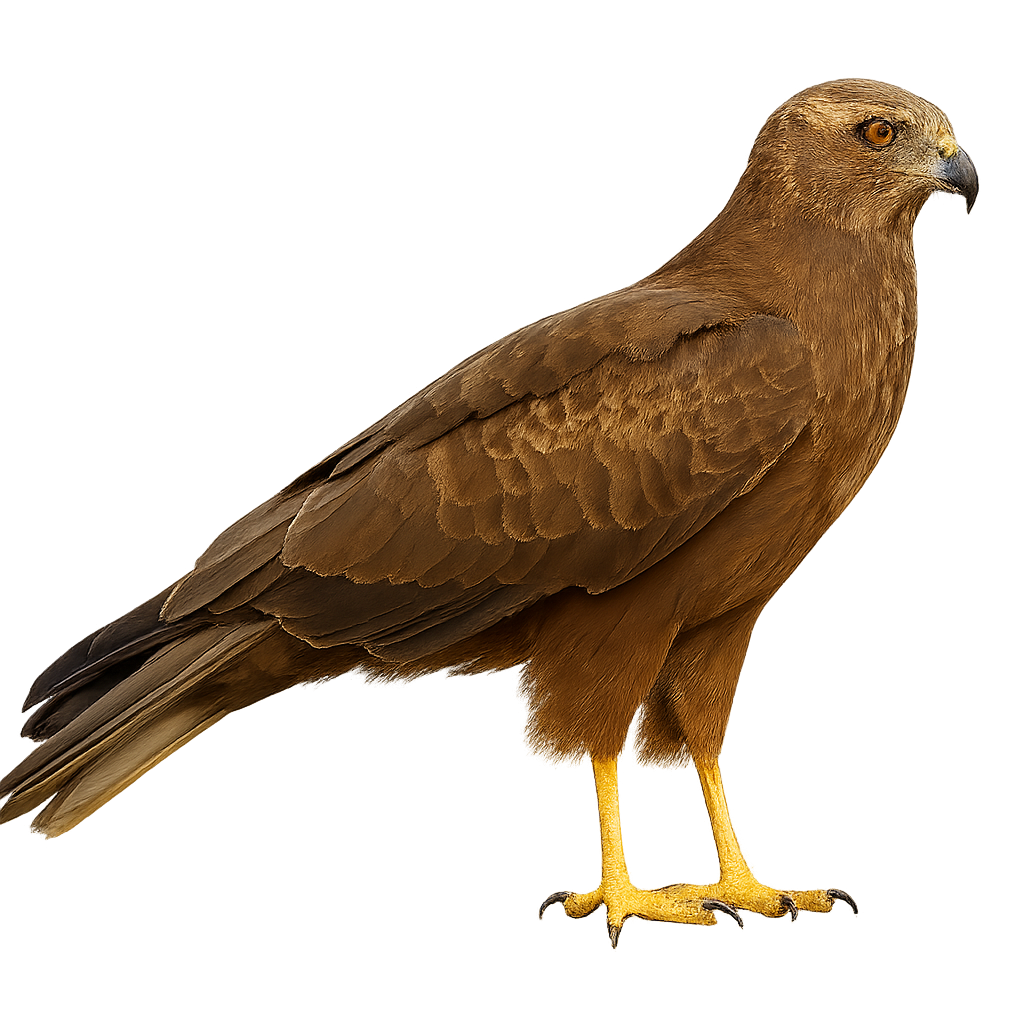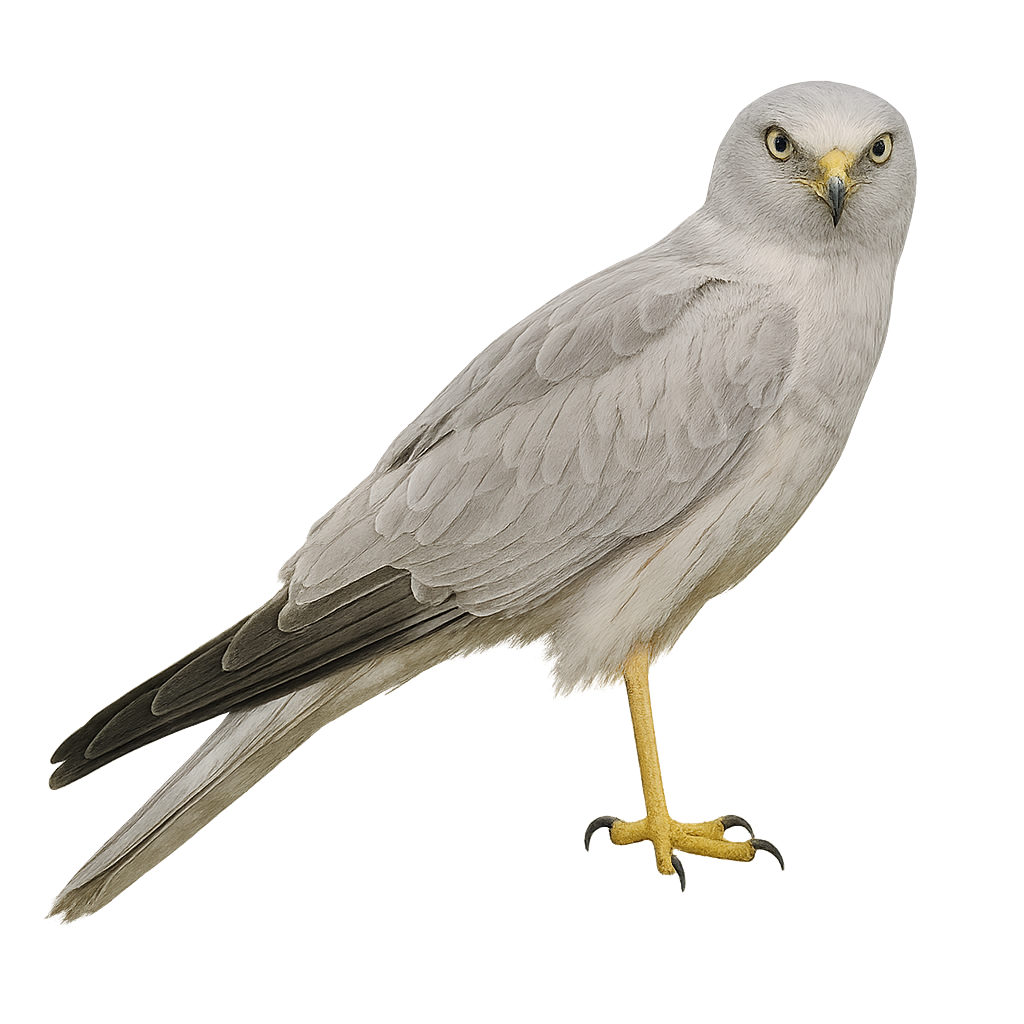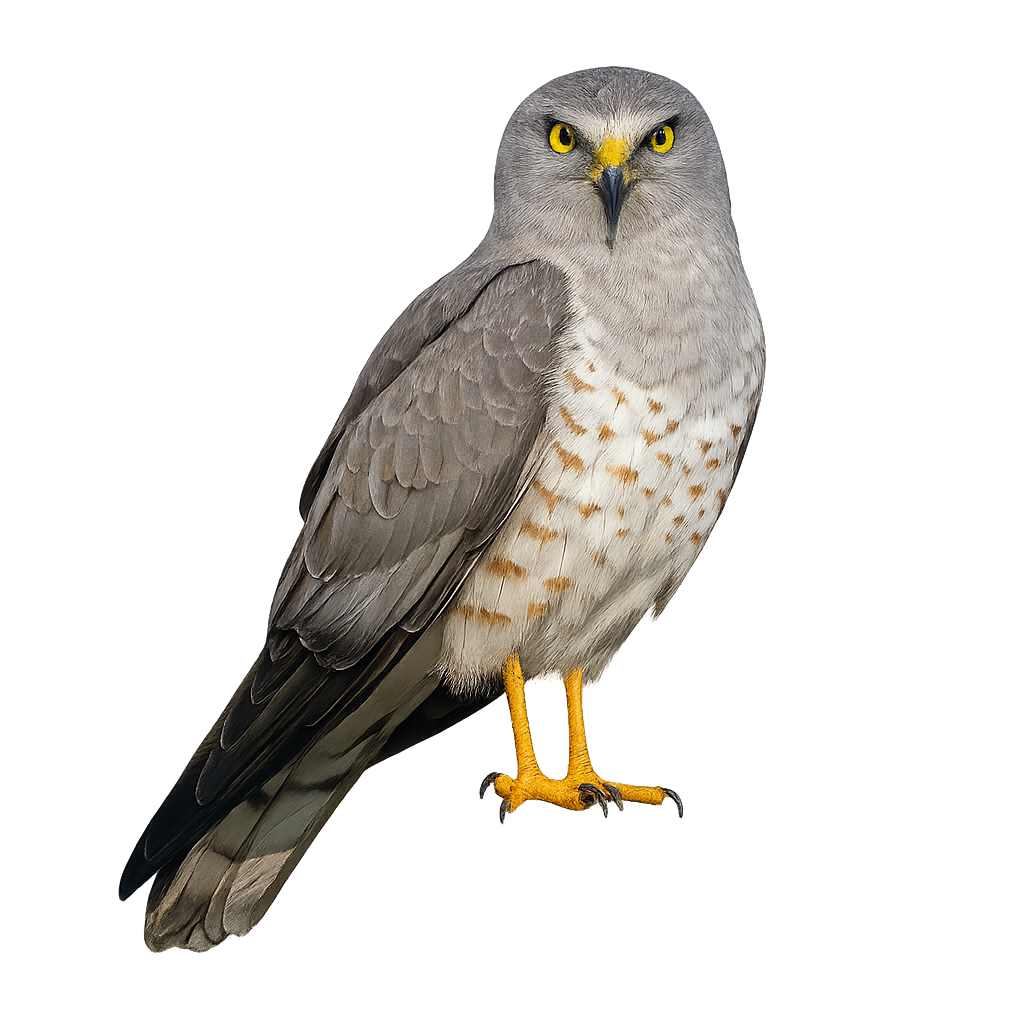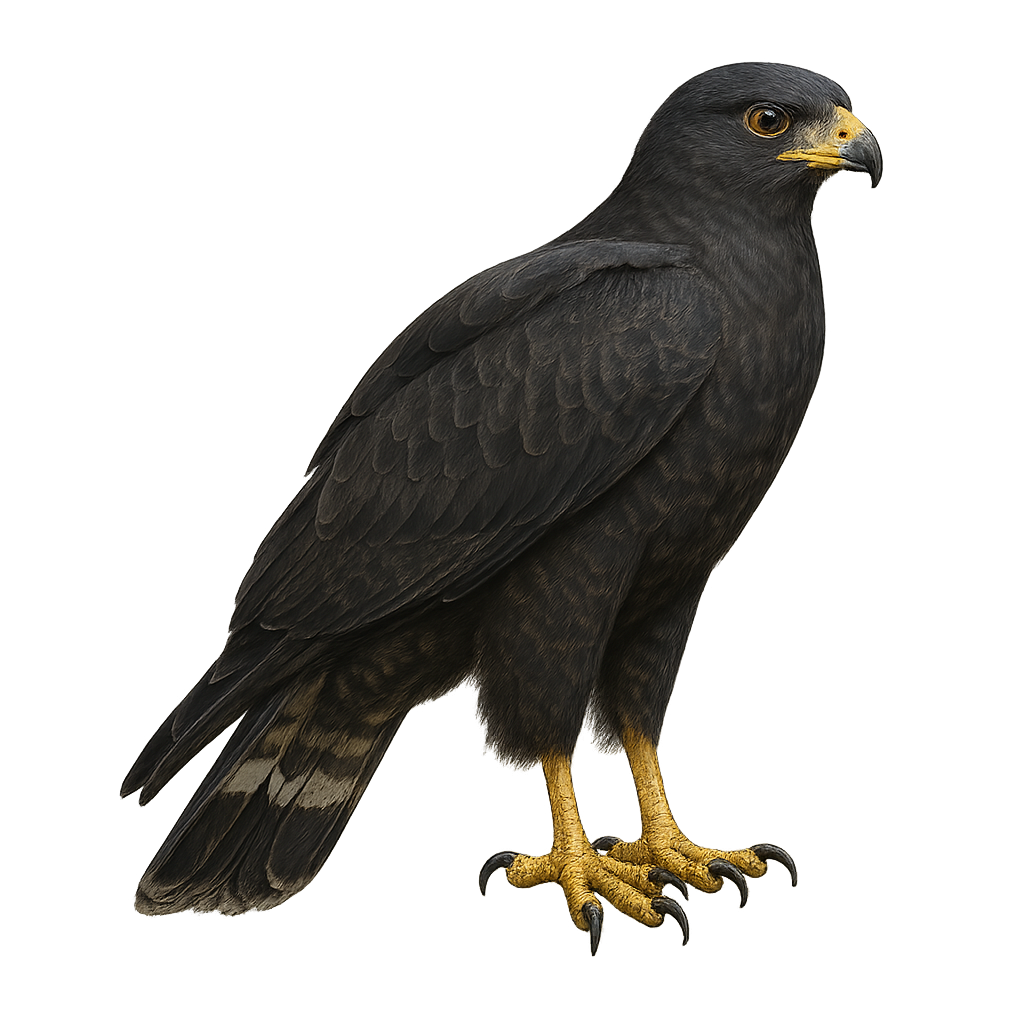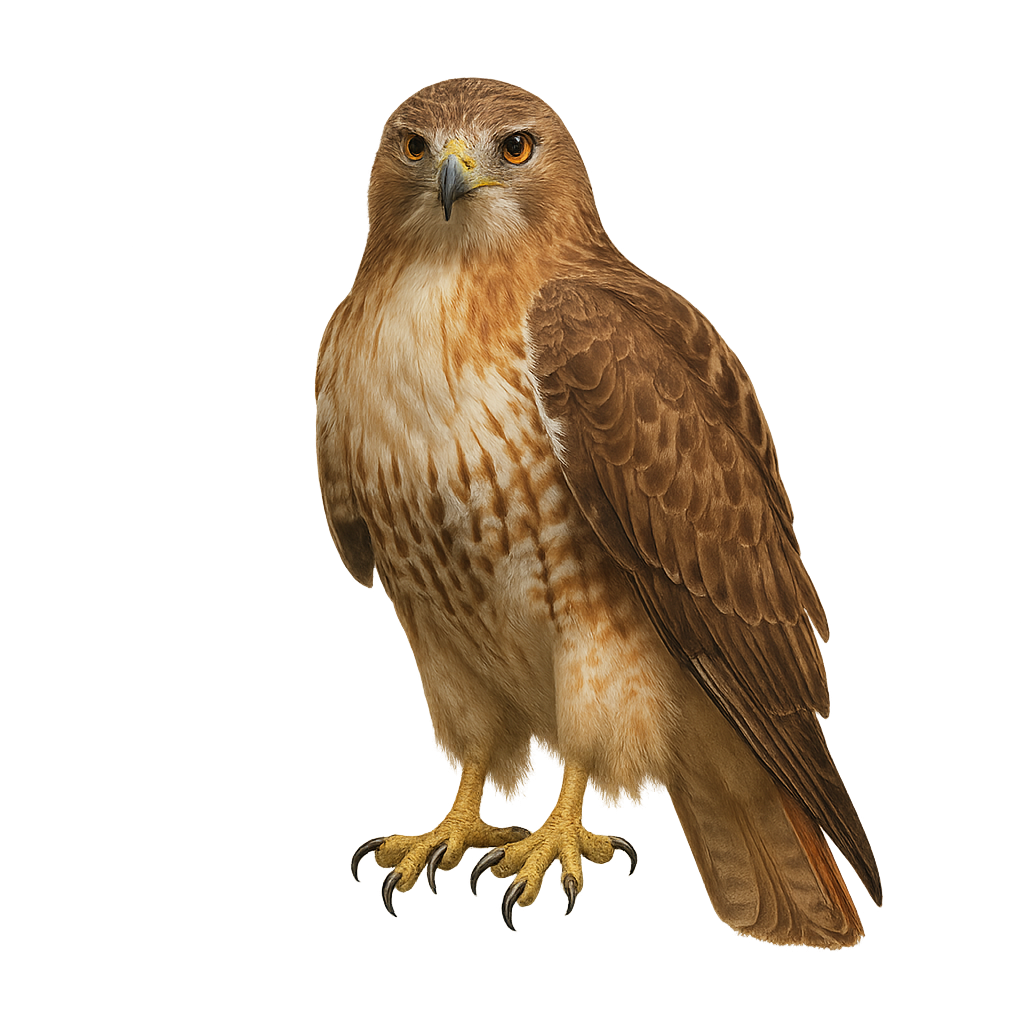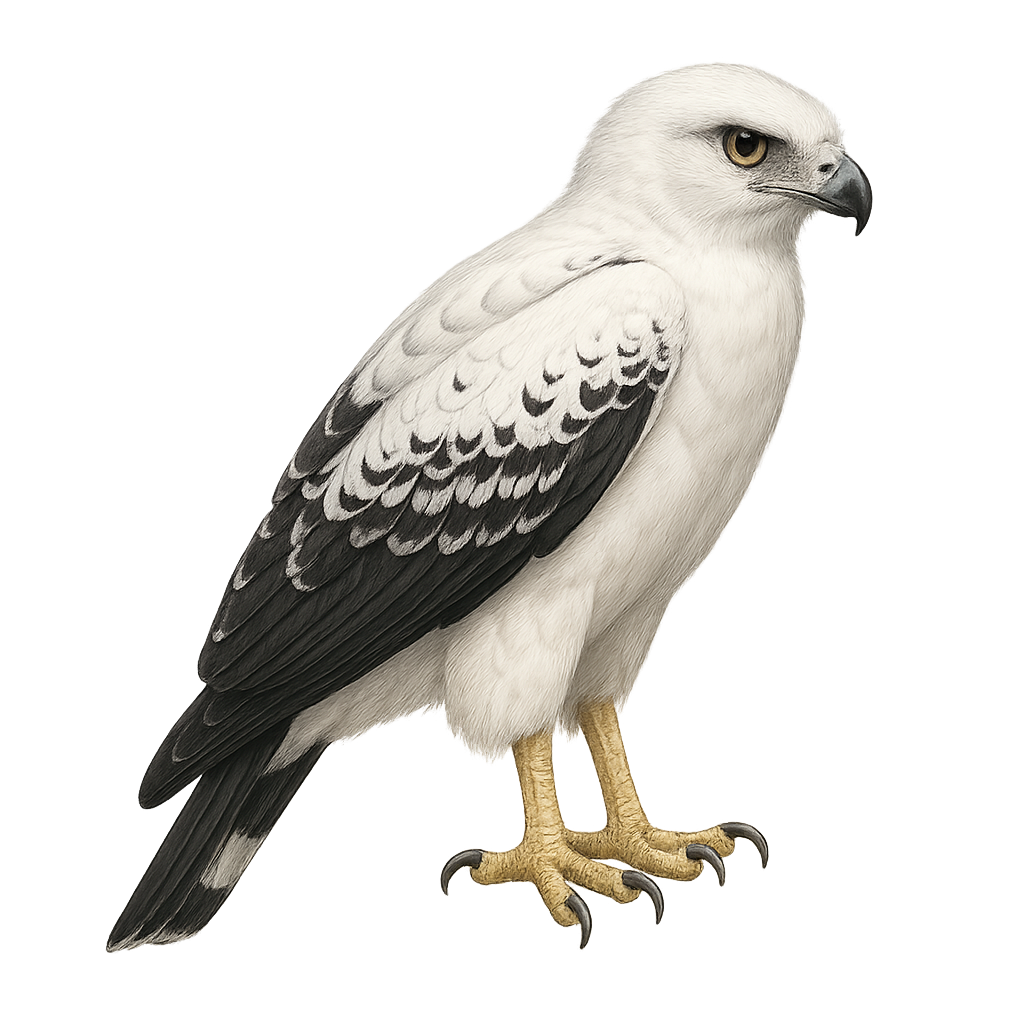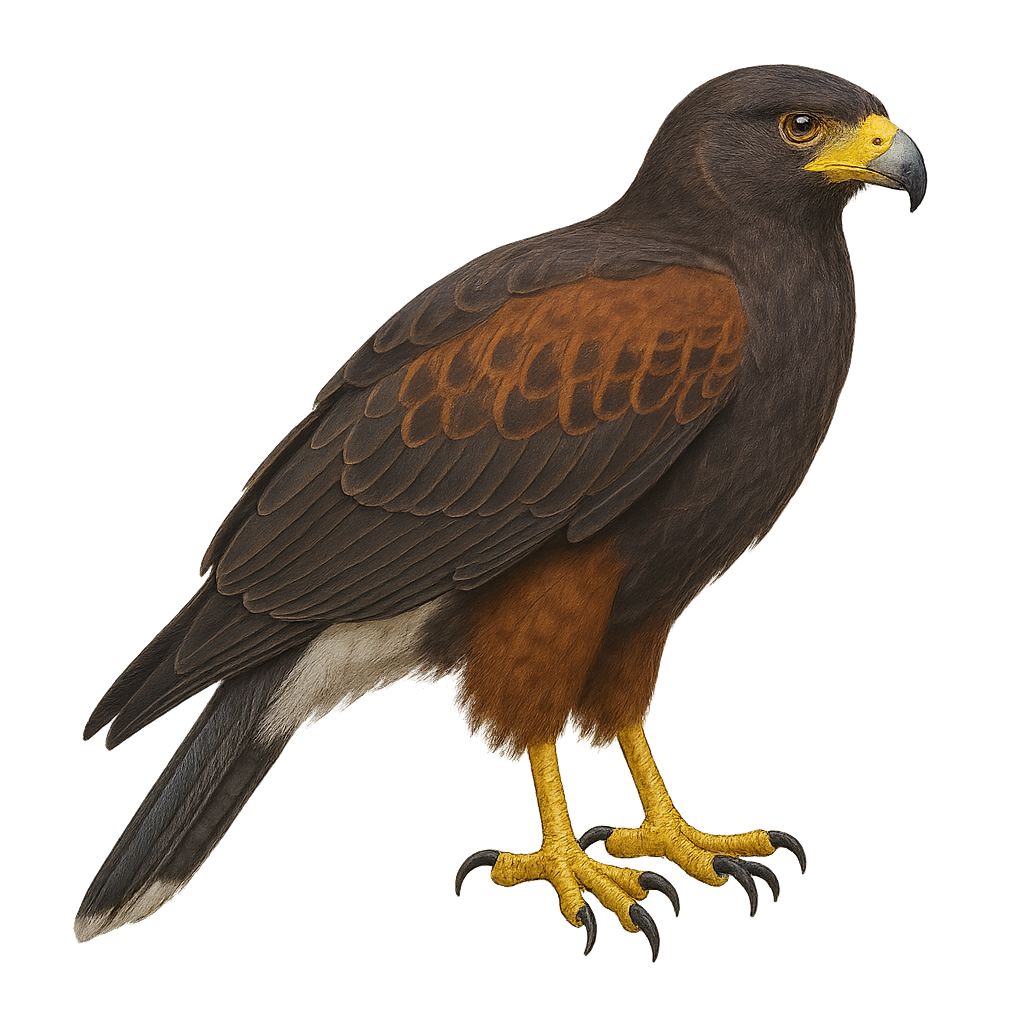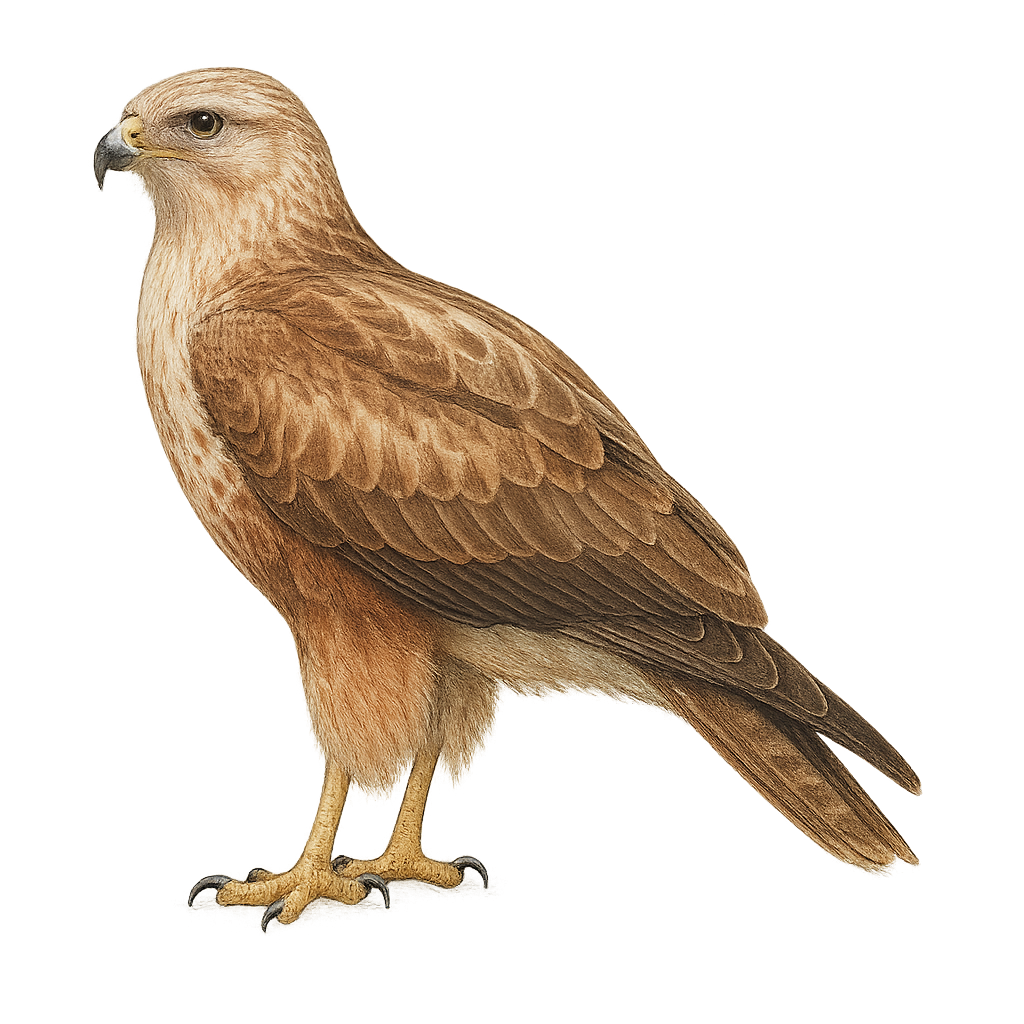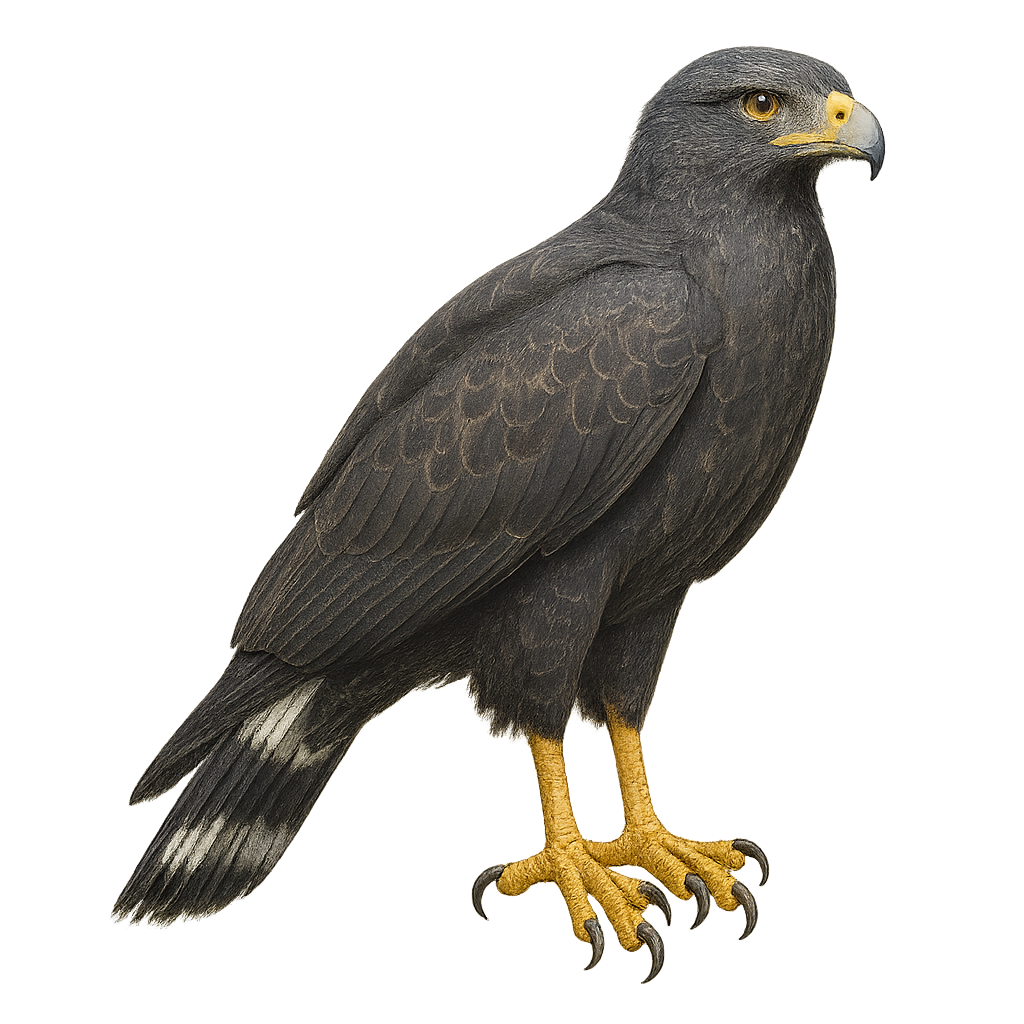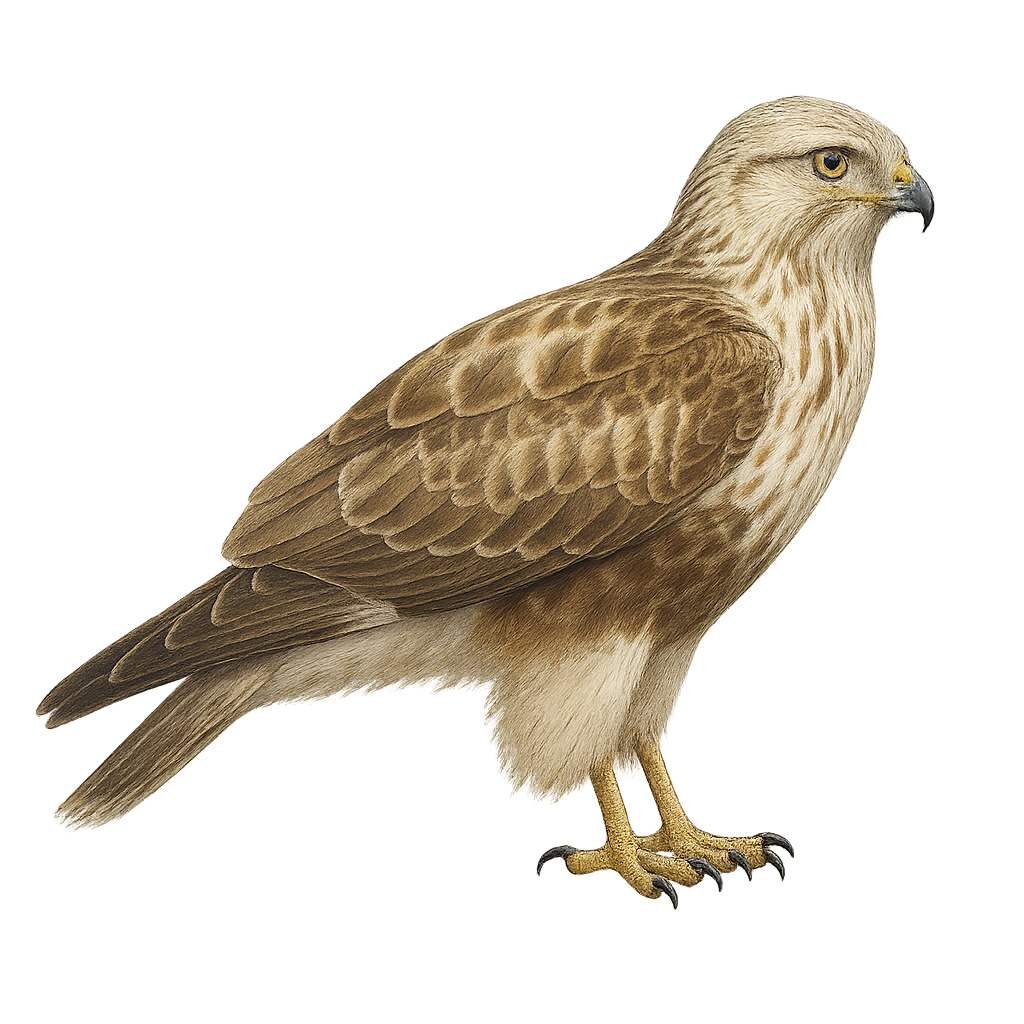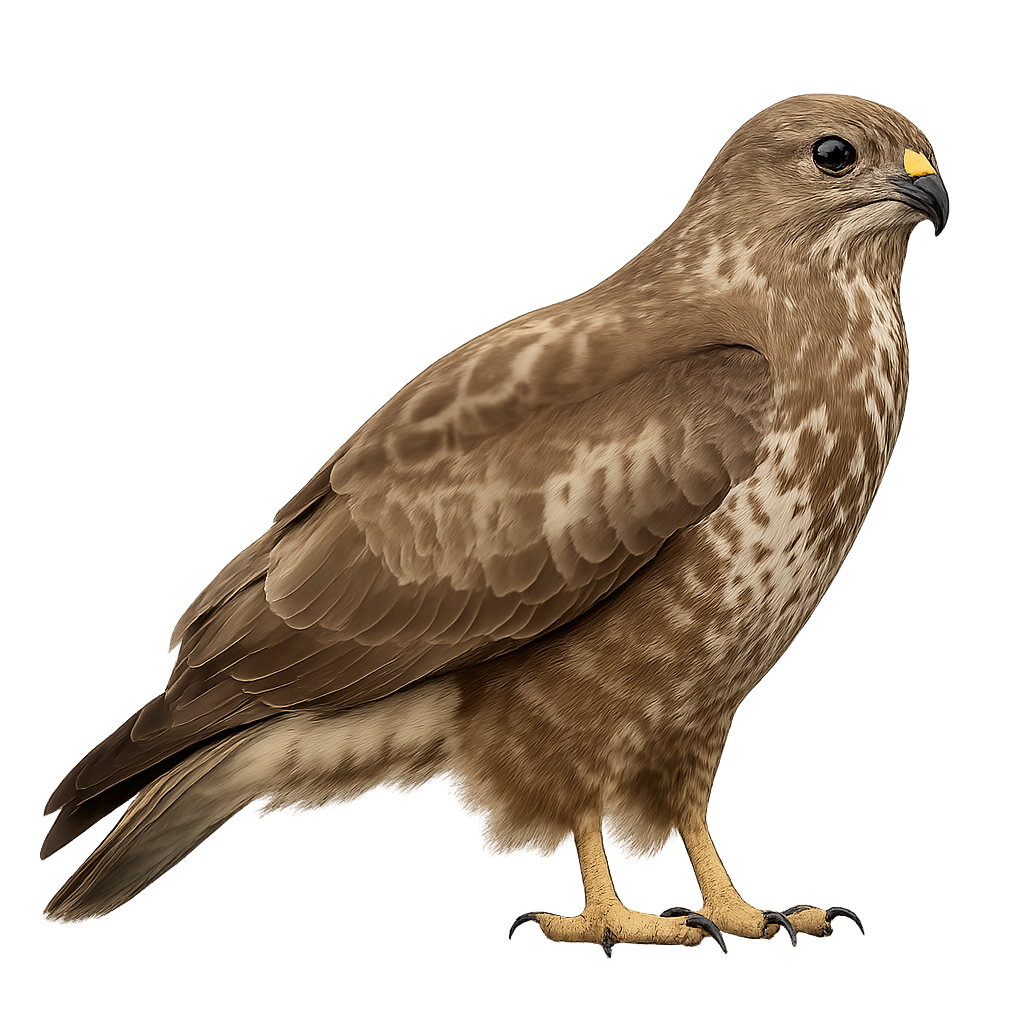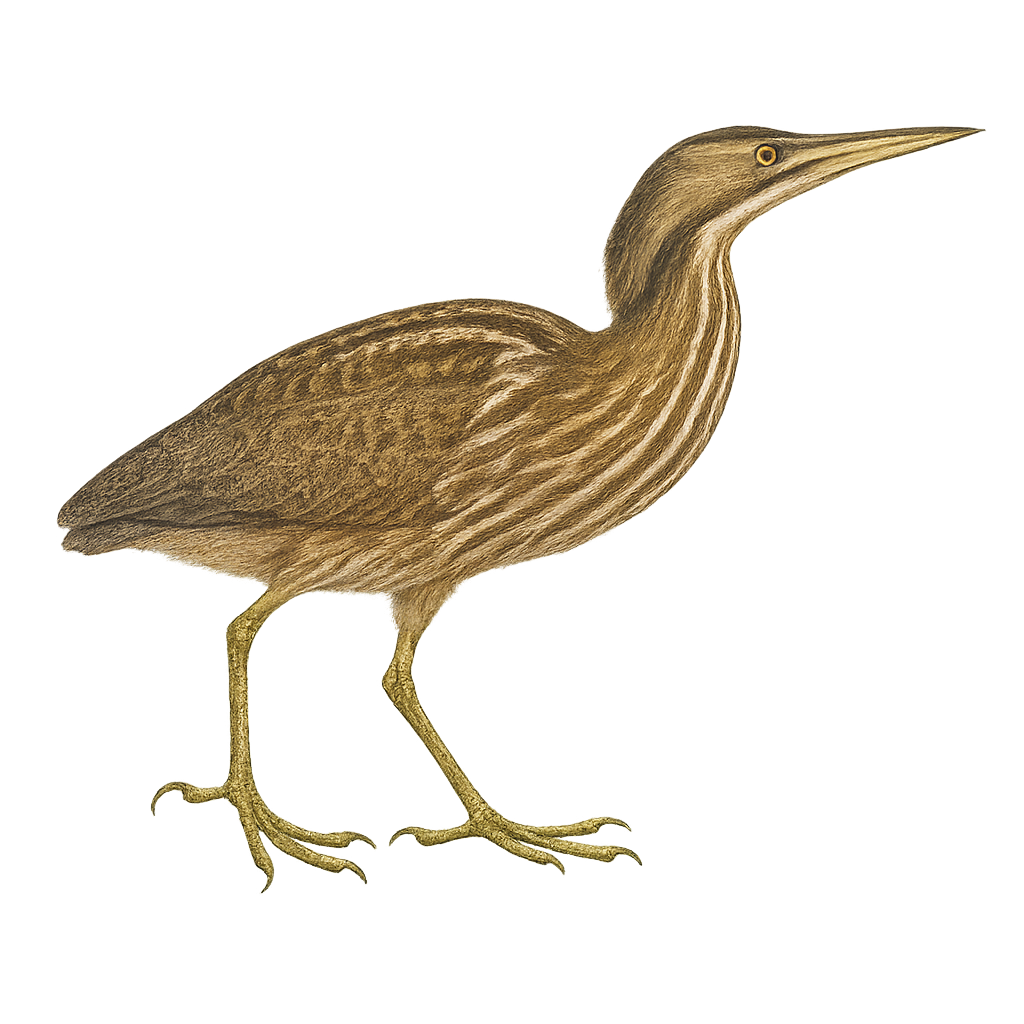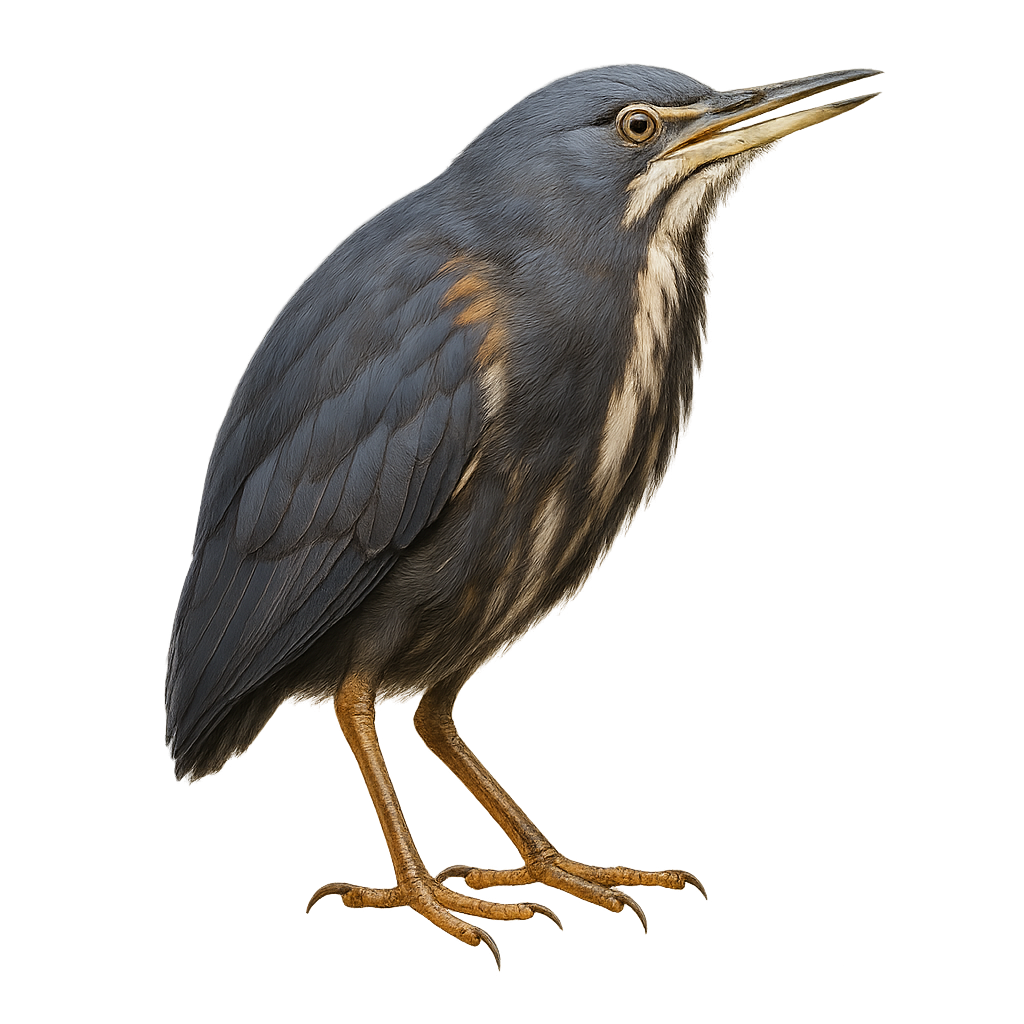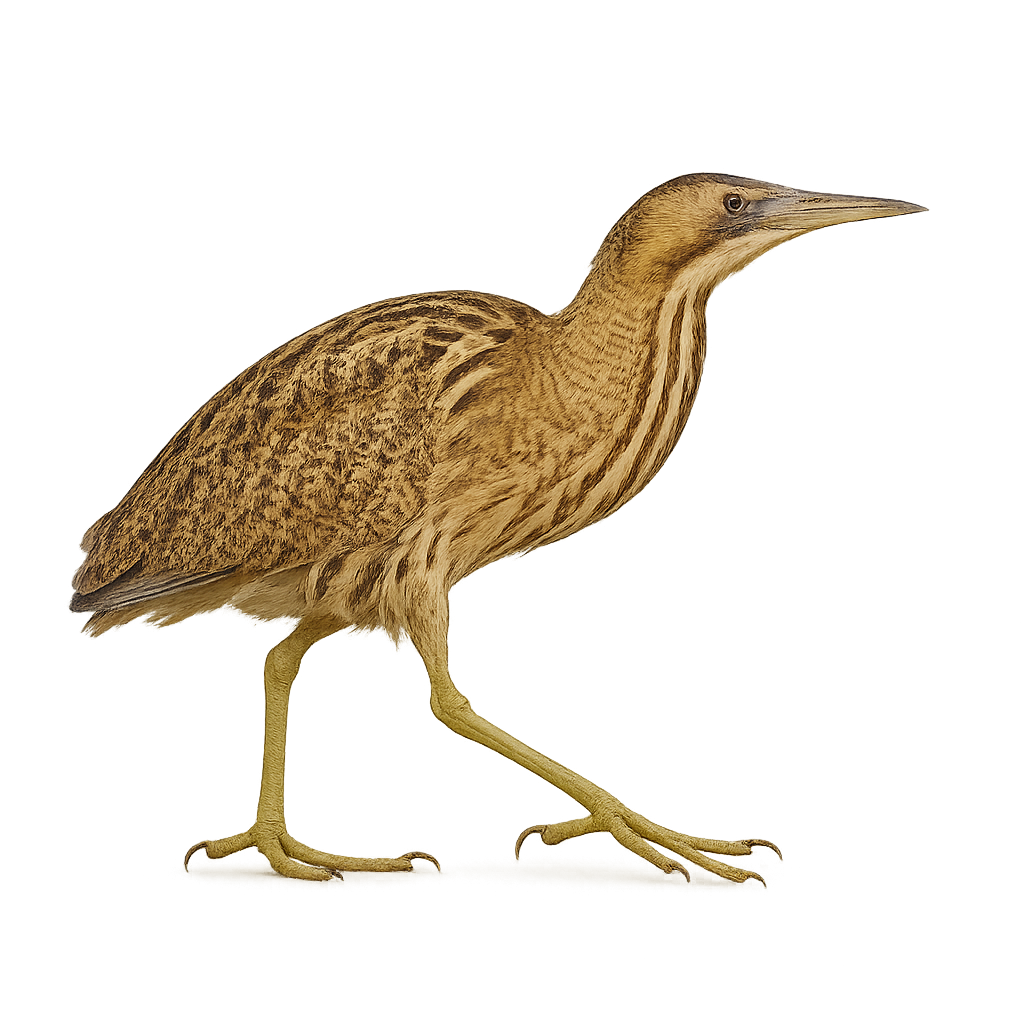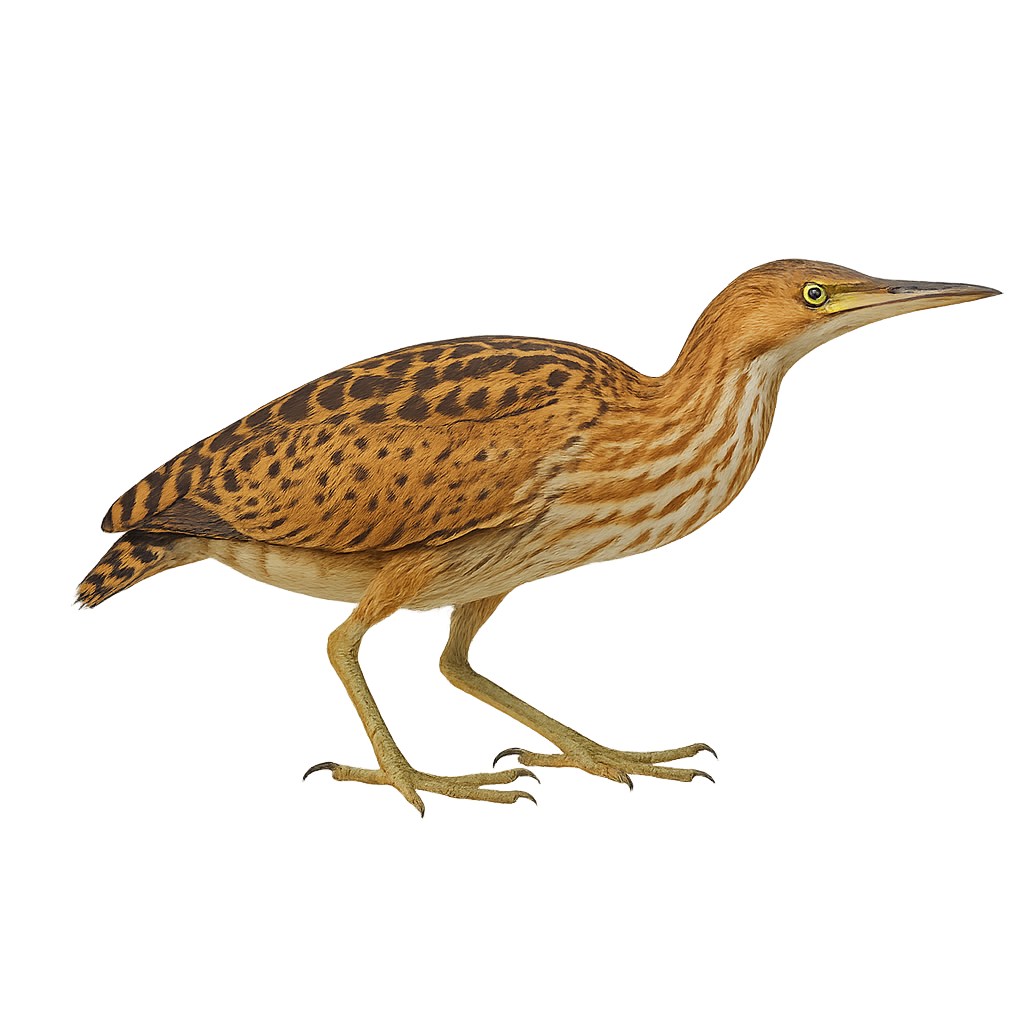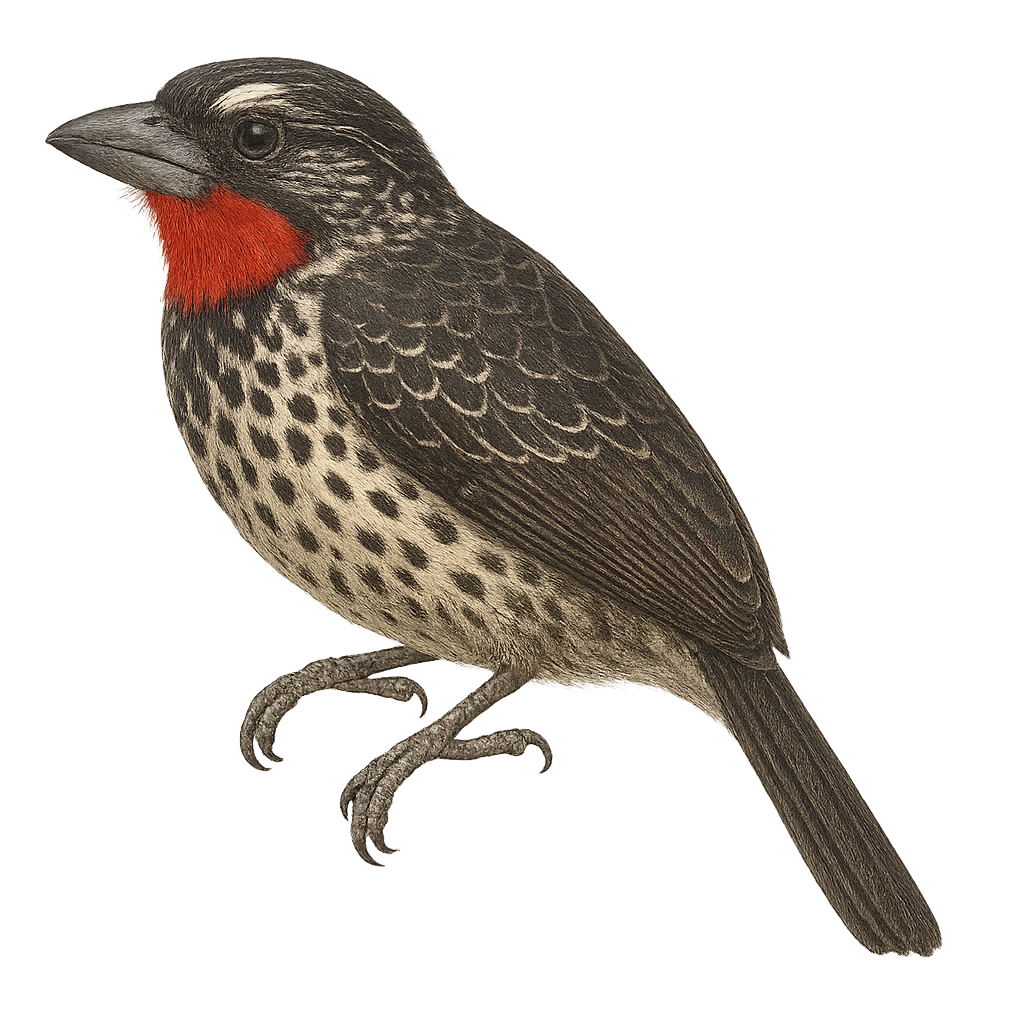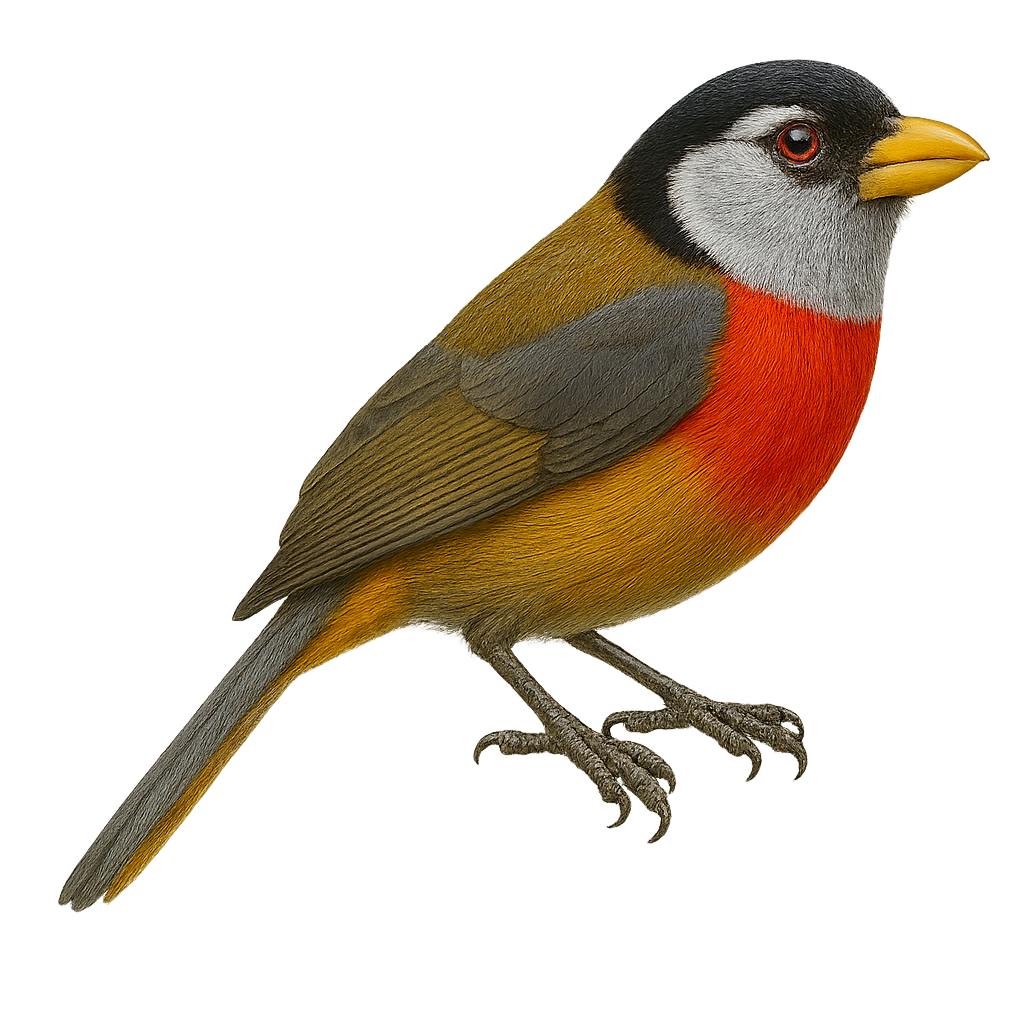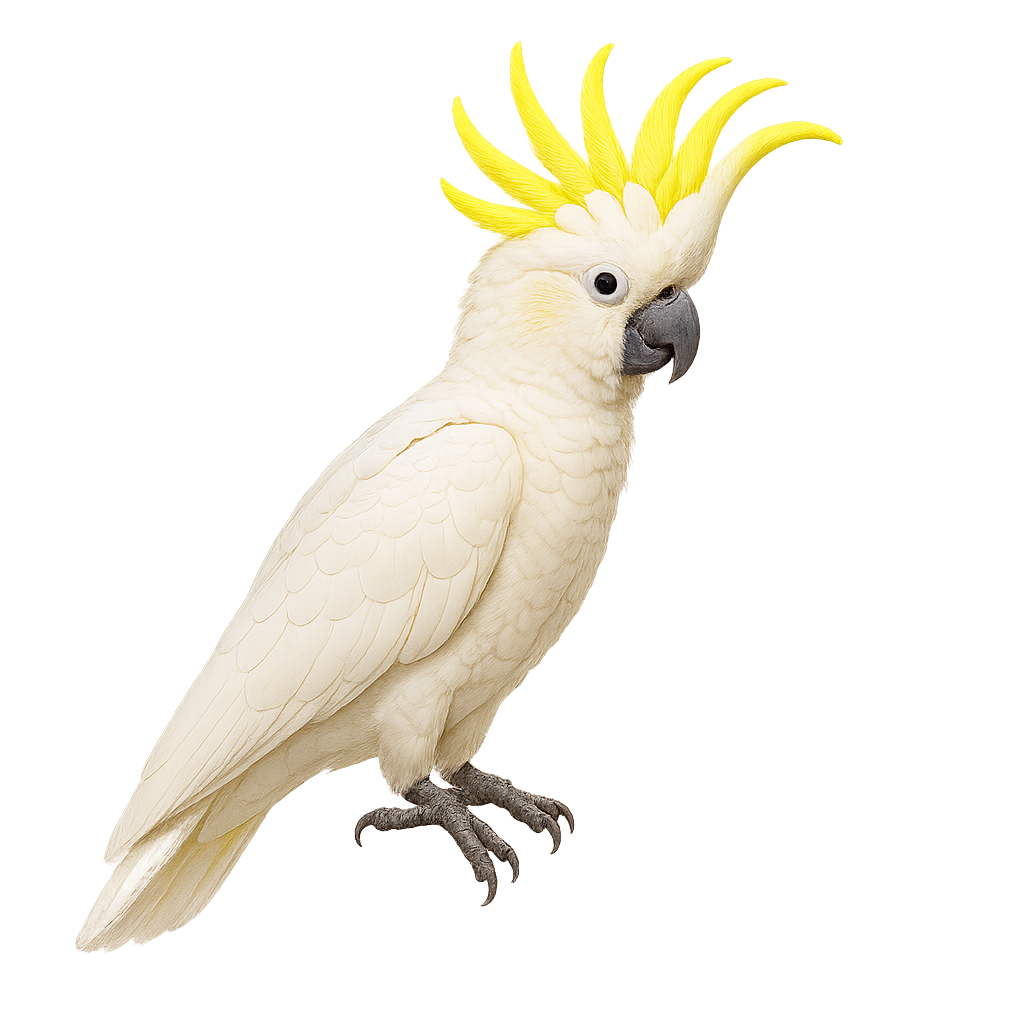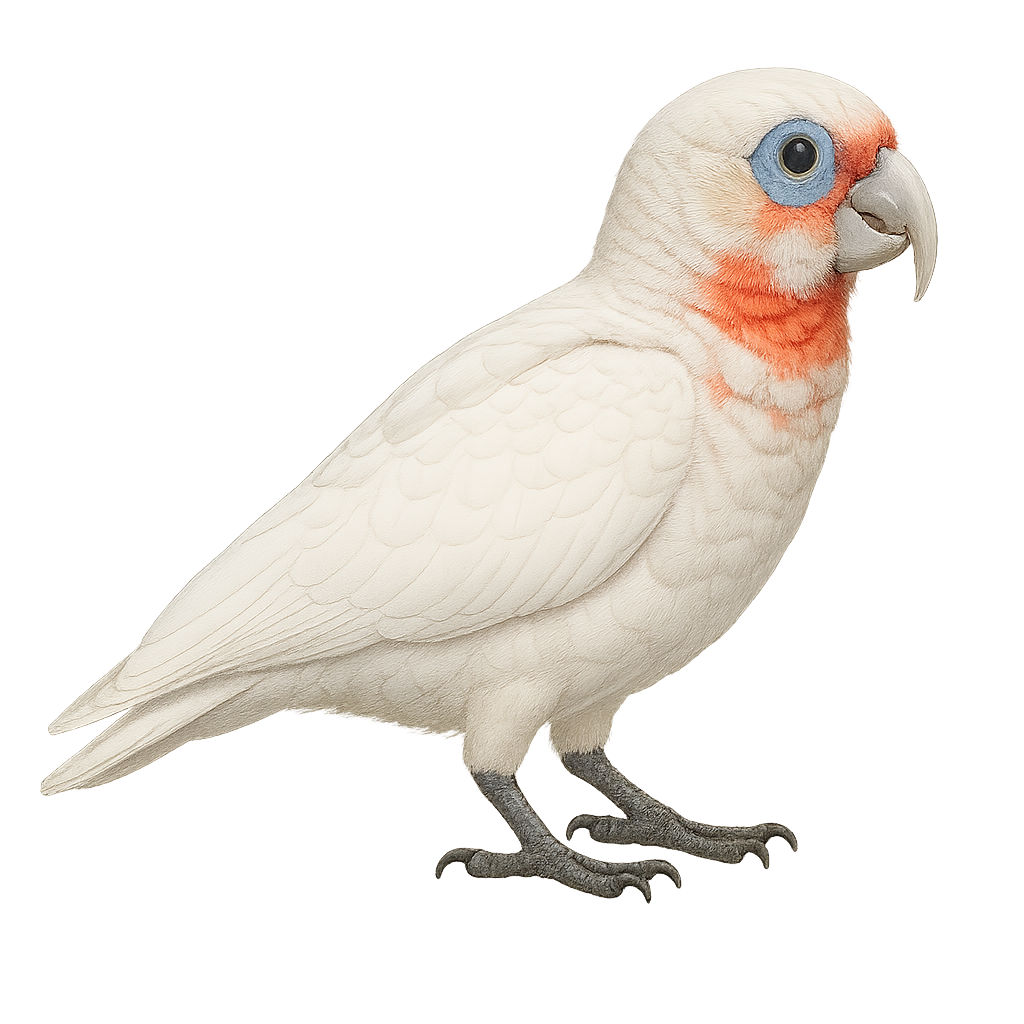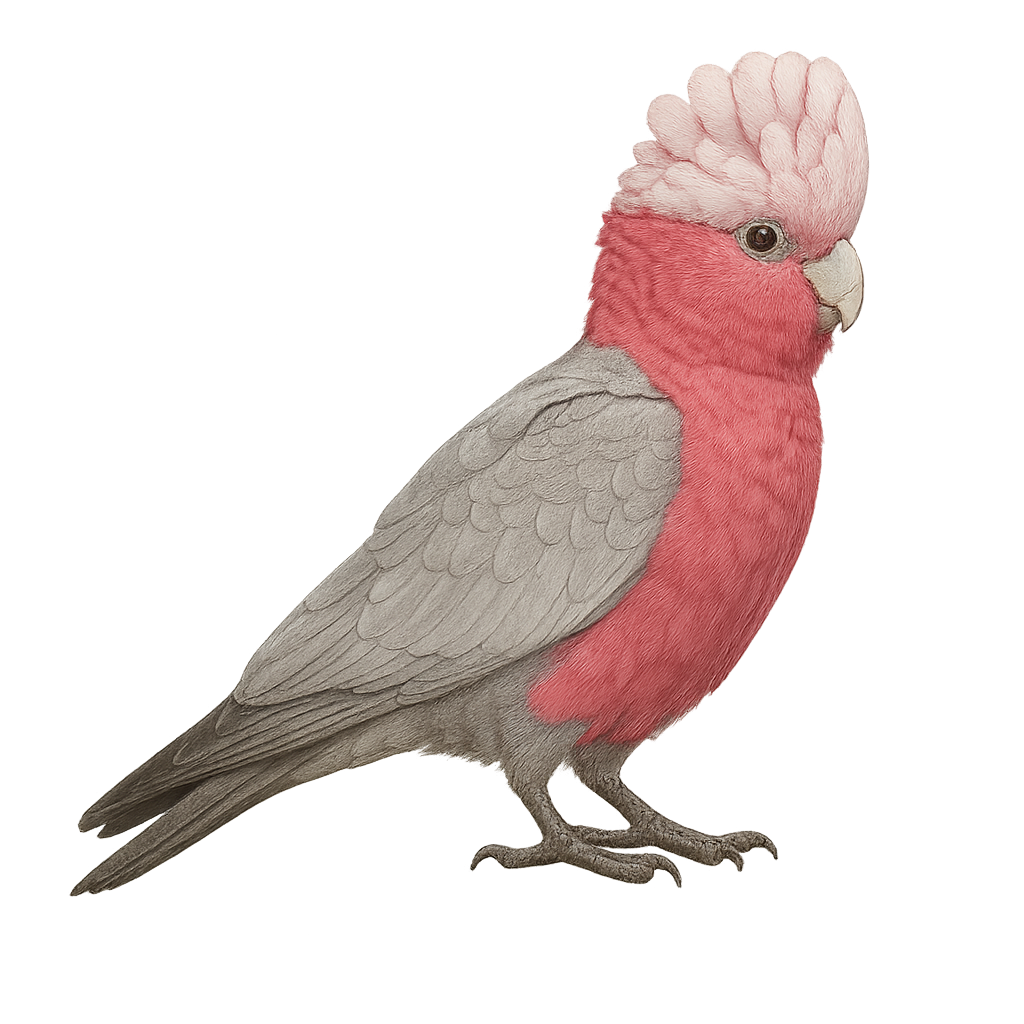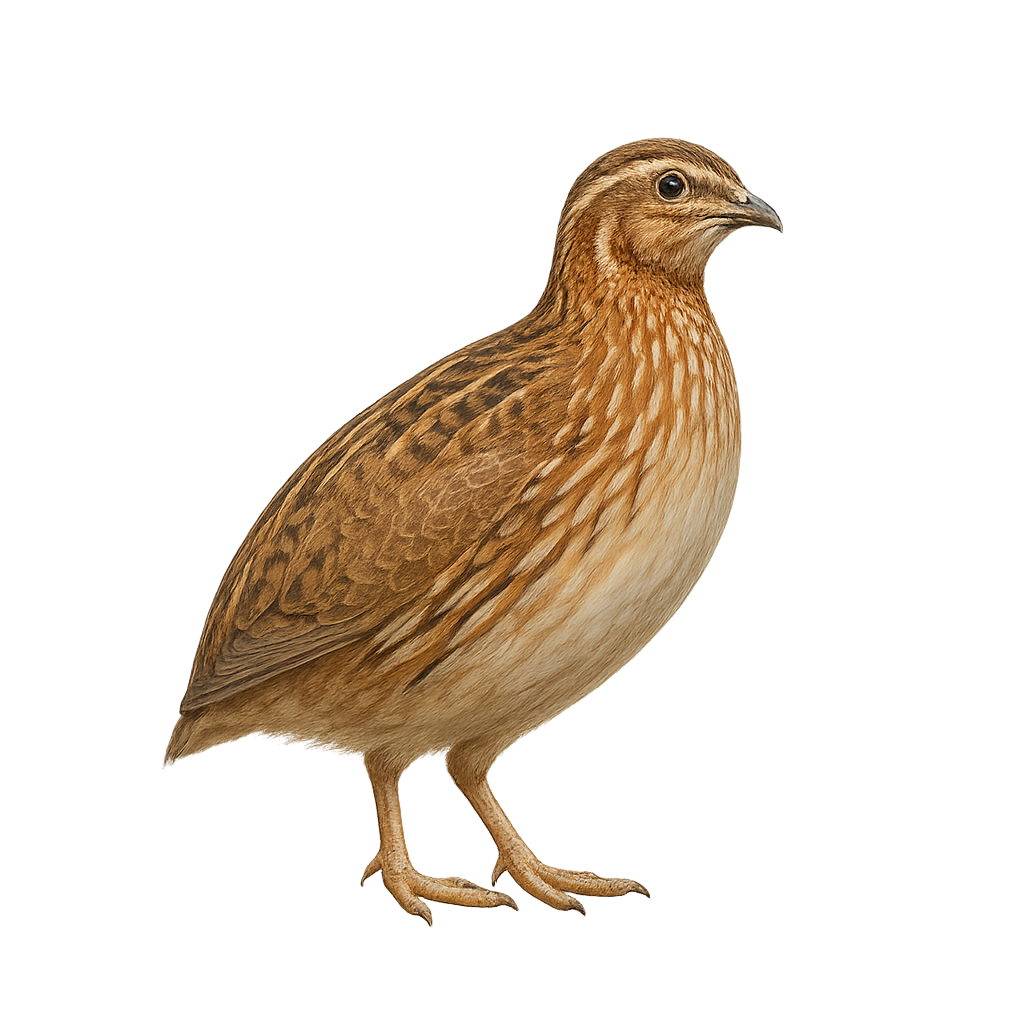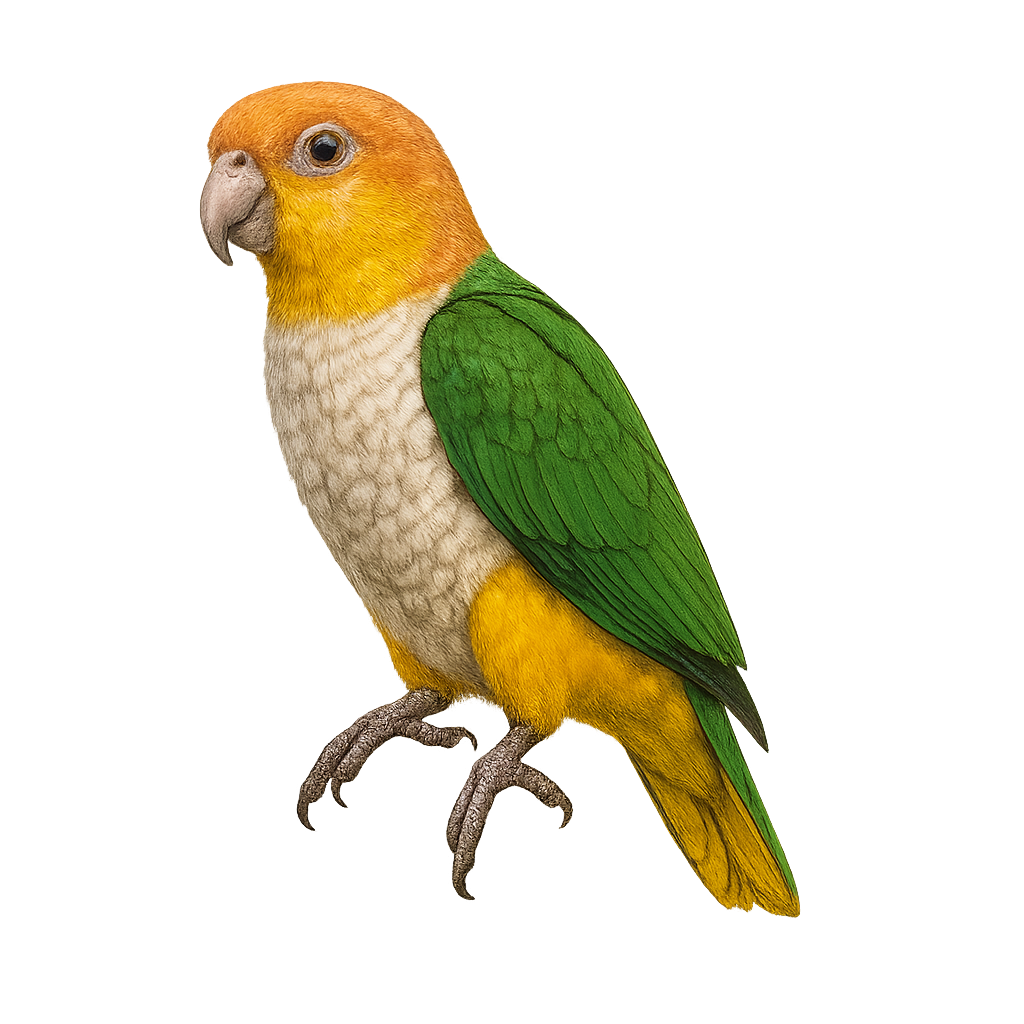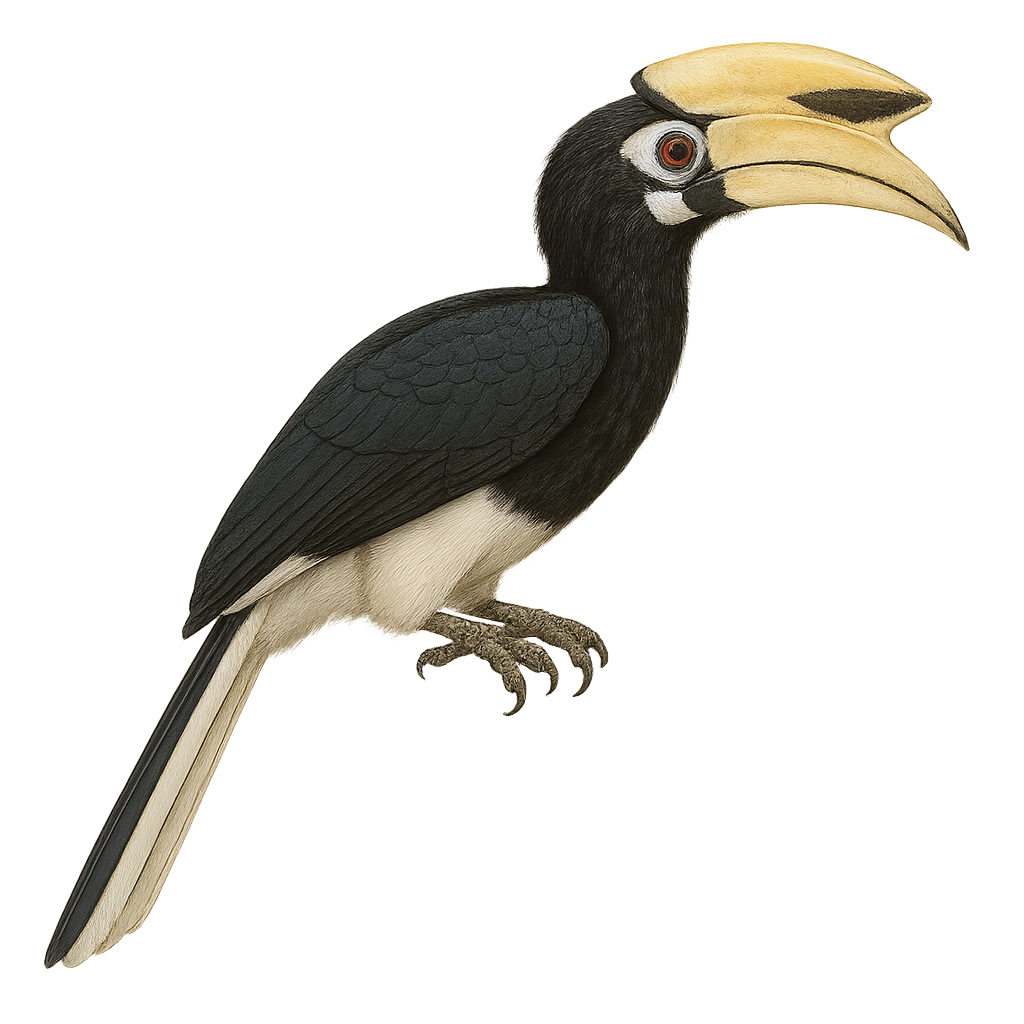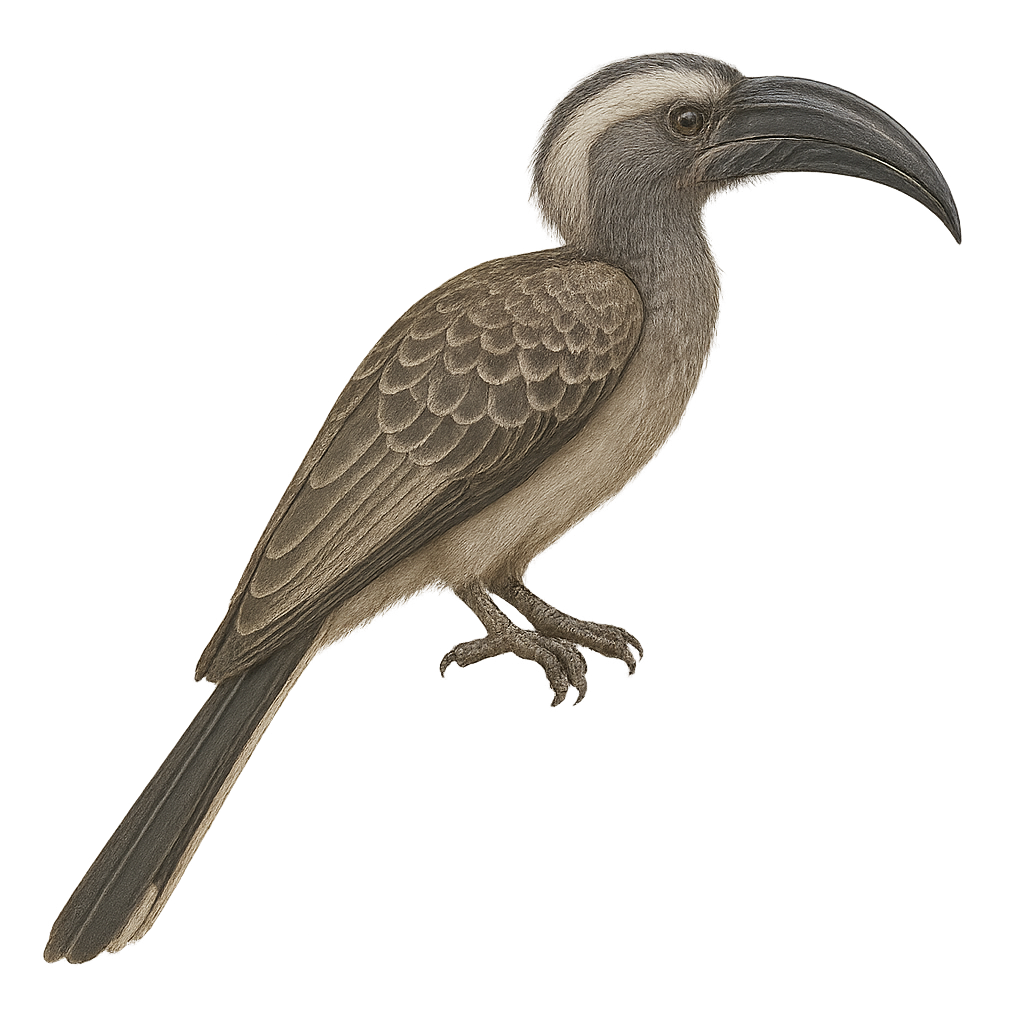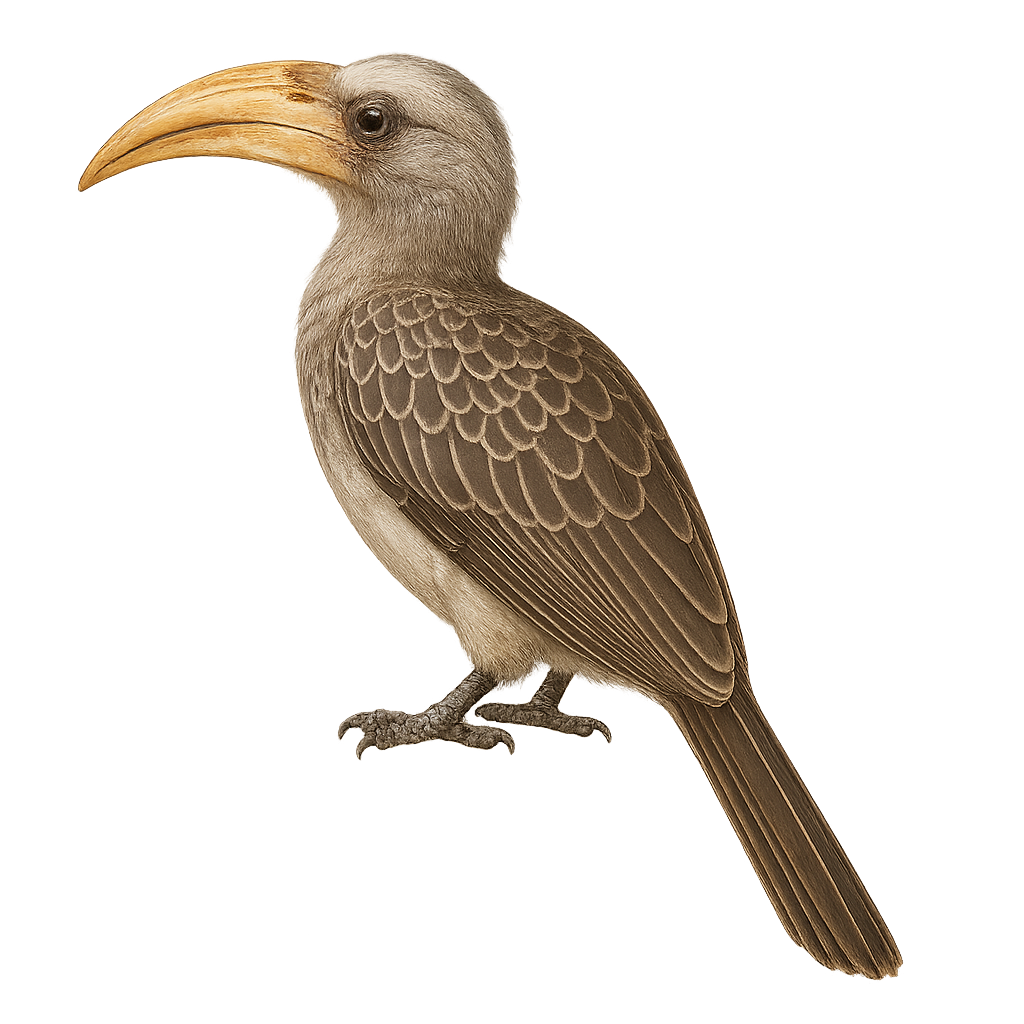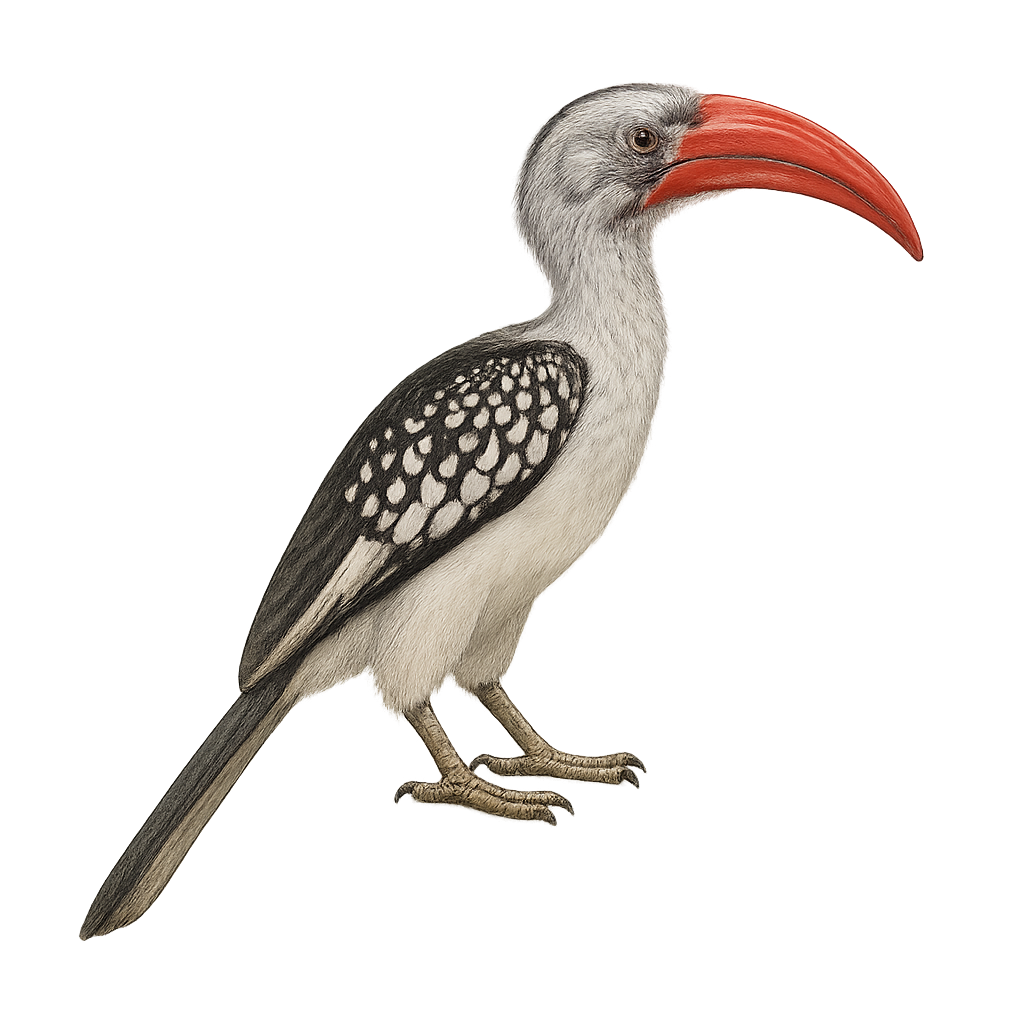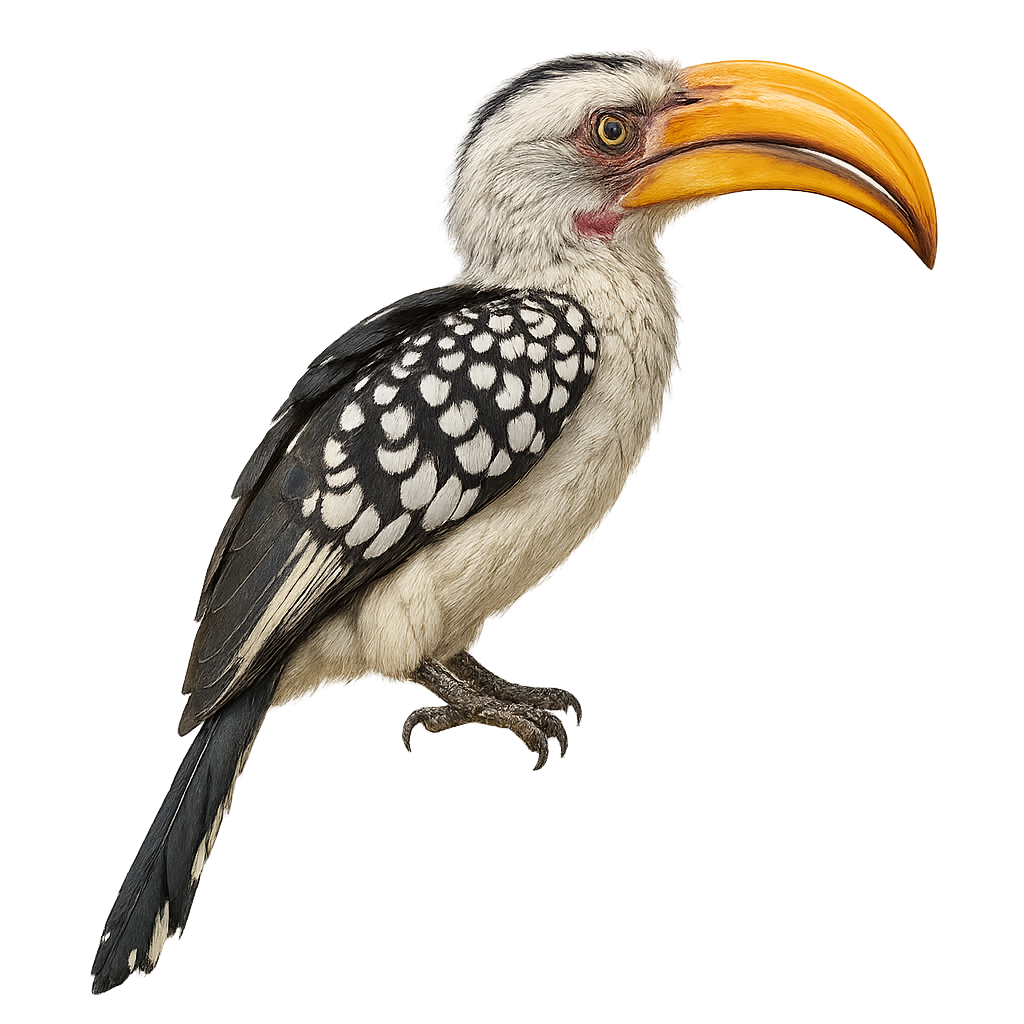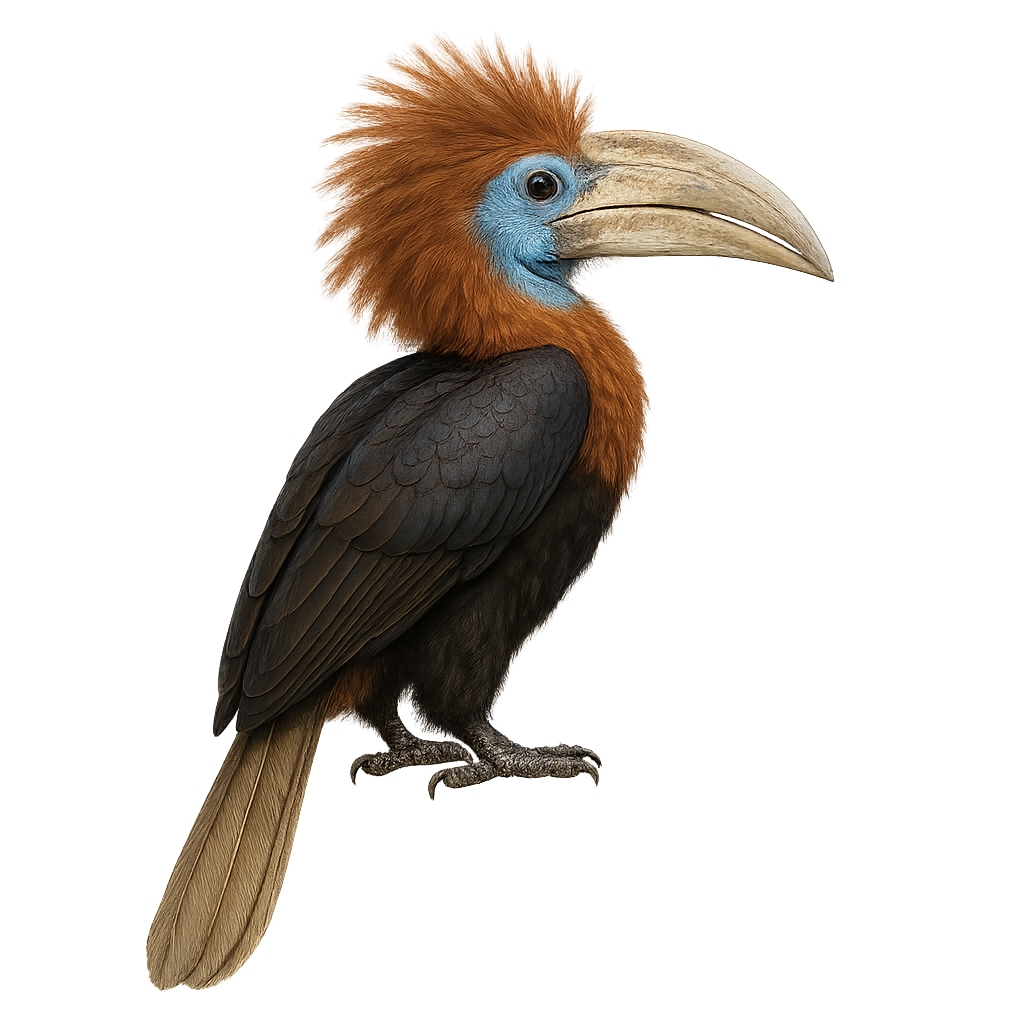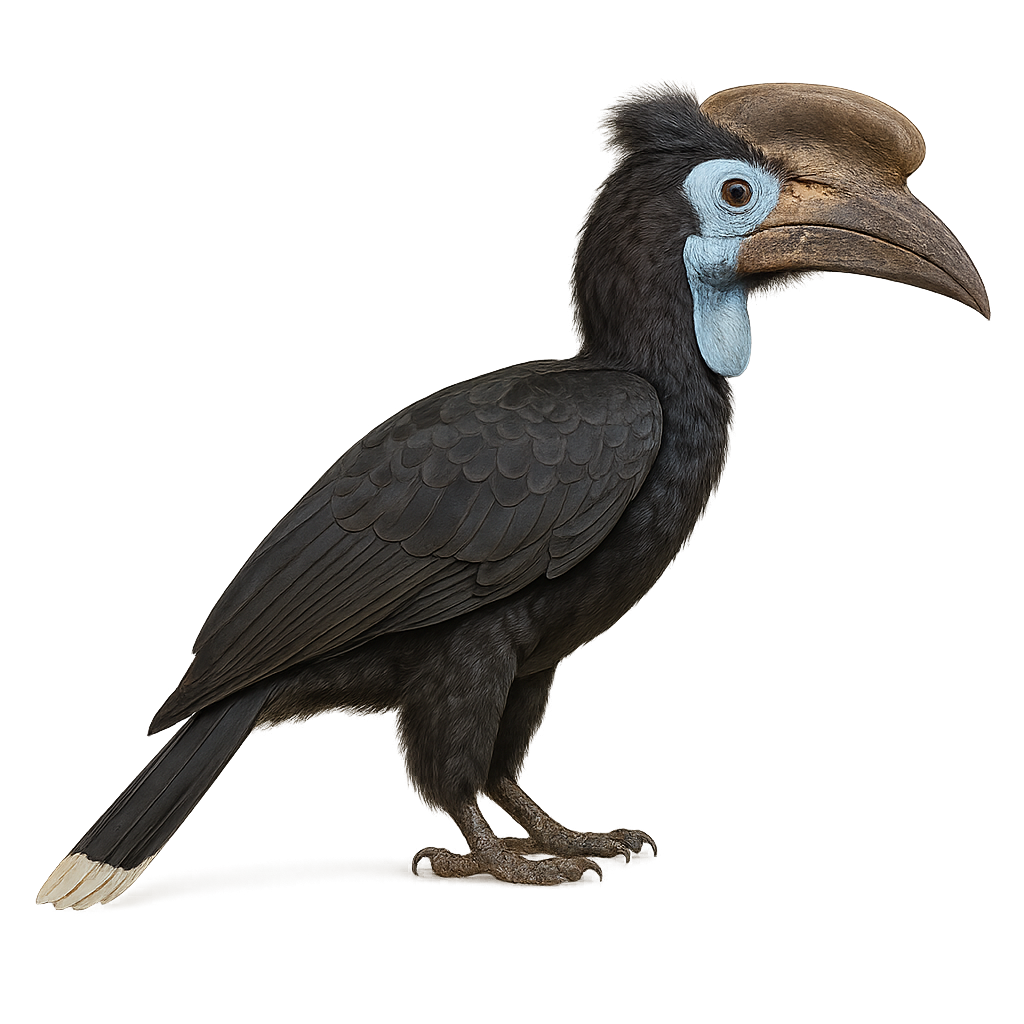The Marsh Harrier is a medium-sized raptor, easily recognized by its brownish-green plumage and slender build. It primarily inhabits wetlands, marshes, and reed beds in Europe, Asia, and North Africa. This diurnal bird hunts small mammals, birds, and insects, which it captures by flying low over the reeds or circling slowly.
The Marsh Harrier is particularly active in spring and summer during the breeding season. Males and females often fly in tandem, searching for food to feed their young. Migratory, it leaves its breeding grounds in Europe to head to North Africa during the winter. While its population remains relatively stable in some areas, the Marsh Harrier faces threats related to habitat loss and pollution in wetland areas.
The Pallid Harrier (Circus macrourus) is a slender, medium-sized raptor (40–48 cm long, 95–115 cm wingspan), with slate-grey breeding plumage in males and mottled brown in females. It occupies open landscapes such as steppes, marshes and wet grasslands, gliding low over the ground to hunt micro-mammals, small birds and large insects. Nestling on the ground from May 1 to July 31, it builds a simple scrape nest hidden under vegetation. A long-distance migrant, it winters from the Sahel to the Indian subcontinent. Populations are vulnerable to steppe loss and agricultural disturbance, although recent trends are relatively stable. As a passage migrant in western Europe, it is eagerly sought by birdwatchers during spring and autumn migrations.
The Northern Harrier is a medium-sized raptor, easily recognizable by its gray and brown plumage, with distinct markings on its wings and a slightly rounded head. This diurnal bird primarily inhabits open areas such as grasslands, cultivated fields, and marshes, mainly in Europe and Asia. The Northern Harrier hunts small mammals, birds, and insects, which it captures by flying low, often making wide circles in search of prey.
This raptor is migratory, leaving its breeding grounds in Europe to head to North Africa during the winter. The Northern Harrier is also known for its majestic flight, which makes it easily identifiable. Although its population is declining in some areas due to habitat loss and human disturbances, conservation efforts are underway to help stabilize its populations.
The Zone-tailed Hawk, or Buteo albonotatus, is a medium-sized raptor known for its distinctive white tail bordered with black. It measures about 48 to 61 cm in length with a wingspan of 117 to 140 cm. Its predominantly dark plumage allows it to blend seamlessly into its natural habitat. This raptor is often mistaken for the Turkey Vulture in flight due to its similar silhouette. It is primarily found in arid and semi-arid regions from the southwestern United States to northern South America. The Zone-tailed Hawk is an opportunistic predator, feeding on small mammals, birds, and reptiles. It is known for its graceful soaring flight and ability to use thermal currents to travel long distances effortlessly.
The Red-tailed Hawk, or Buteo jamaicensis, is a widespread diurnal raptor in North America. It is easily recognizable by its distinctive red tail, although juveniles have a duller tail. Its plumage ranges from dark brown to light brown, with a typically paler belly. This opportunistic predator primarily feeds on small mammals but can also capture birds and reptiles. The Red-tailed Hawk is often seen perched on poles or soaring in circles in the sky. It adapts to various habitats, from forests to open grasslands, and is known for its piercing and distinctive call.
The White Hawk, Pseudastur albicollis, is a medium-sized raptor known for its predominantly white plumage with black wings and tail. It inhabits dense tropical forests in Central and South America, feeding mainly on reptiles, small mammals, and birds. Its flight is majestic, often soaring above the canopy. It is known for its piercing call, used to mark its territory. Although generally solitary, it can be seen in pairs during the breeding season. Its adaptability to various forest habitats makes it a resilient species despite increasing deforestation.
The Harris's Hawk, Parabuteo unicinctus, is a medium-sized raptor known for its dark brown plumage, reddish shoulders, and white-tipped tail. It is particularly noted for its unique social behavior among raptors, often hunting in organized groups, allowing it to capture larger and faster prey. Native to the arid and semi-arid regions of the Americas, it adapts well to various environments, from deserts to mangroves. Its ability to cooperate and communicate with its peers makes it a fascinating subject of study for ornithologists. In captivity, it is often used in falconry due to its intelligence and ease of training.
The Long-legged Buzzard, or Buteo rufinus, is a medium to large-sized raptor known for its long wings and relatively short tail. It has a variable plumage ranging from light brown to rufous, with darker markings on the wings and tail. This bird of prey is often seen soaring in circles, using thermal currents to rise. It primarily inhabits open areas such as steppes, semi-deserts, and grasslands, but can also be found in mountainous regions. The Long-legged Buzzard feeds mainly on small mammals, birds, and occasionally reptiles. It is known for its powerful flight and ability to cover long distances during migration.
The Common Black Hawk, scientifically known as Buteogallus anthracinus, is a medium-sized raptor found primarily in coastal regions and riparian forests of Central America and the southern United States. Its plumage is predominantly black with bluish sheen, and it features a distinctive white band on its tail. This bird of prey is often seen soaring above waterways, hunting for prey such as fish, crabs, and small vertebrates. Its call is a sharp, piercing whistle. The Common Black Hawk is territorial, often solitary or in pairs, and builds its nest in trees, usually near water.
The Rough-legged Buzzard, or Buteo lagopus, is a medium-sized bird of prey known for its feathered legs, which help it endure cold climates. It features a brown plumage speckled with white, with a white tail barred with black. This raptor is often seen hovering, scanning the ground for prey, mainly rodents. It breeds in arctic and subarctic regions but migrates southward in winter. The Rough-legged Buzzard is a solitary bird, although it can be seen in small groups during migration. It prefers open habitats such as tundras, grasslands, and agricultural areas.
The Common Buzzard is a medium-sized diurnal raptor, easily recognizable by its often spotted and banded brown and white plumage, which gives it a particularly variable appearance from one individual to another. It primarily inhabits open forests, hedgerows, and agricultural landscapes in Europe, Asia, and North Africa. The Common Buzzard feeds on small mammals, birds, and occasionally insects, which it hunts on the ground, often perched on a tree or pole, waiting for the right moment to swoop down on its prey.
This raptor is known for its characteristic flight, often soaring in the sky in wide circles. The Common Buzzard is also a migratory bird, leaving some of its breeding grounds in Europe to migrate to warmer regions during the winter. While the population of the Common Buzzard is stable in many areas, it can be affected by habitat loss and human persecution.
The American Bittern, Botaurus lentiginosus, is a medium-sized wading bird belonging to the Ardeidae family. It is primarily found in North America, inhabiting marshes and wetlands. Its brown plumage with darker streaks provides excellent camouflage among reeds. Known for its distinctive call, often likened to a water pump, the American Bittern feeds mainly on fish, insects, and small mammals. Although elusive, it can sometimes be seen standing still, adopting a vertical posture to blend into its surroundings.
The Sturm's Bittern, or Botaurus sturmii, is a rare and elusive bird belonging to the Ardeidae family. It is primarily found in the wetlands of Central and West Africa, where it skillfully camouflages itself among reeds and tall grasses. This medium-sized bittern has a streaked brown plumage that allows it to blend into its surroundings. It is most active at dusk and dawn, when it emits characteristic loud calls. Its population is difficult to estimate due to its secretive nature and often inaccessible habitat. Conservation of its natural habitats is crucial for its survival.
The Great Bittern is a large, secretive heron, easily recognized by its brown spotted and striped plumage, which allows it to blend perfectly into the reeds and vegetation of wetland areas where it lives. This nocturnal and solitary bird primarily inhabits marshes, ponds, and reed beds in Europe, Asia, and North Africa. It feeds mainly on fish, amphibians, and small birds, which it hunts by silently creeping through aquatic plants or standing still to wait for its prey.
The Great Bittern is an excellent master of camouflage, using its plumage to conceal itself in its environment, making it difficult to observe. Migratory, it leaves its breeding grounds to travel to Africa during the winter. While it is listed as "Near Threatened" on the IUCN Red List, it remains vulnerable to habitat loss due to wetland drainage and urbanization.
A nocturnal and secretive marsh heron, this bulky bird with cryptic buff-brown plumage hides among reeds to feed on insects, fish and small vertebrates from ambush. When moving, it crouches with neck erect and emits deep booms at dusk during the breeding season.
The Black-spotted Barbet, or Capito niger, is a bird from the Capitonidae family, primarily found in the humid tropical forests of South America. It is characterized by its glossy black plumage, accented with white spots on the wings and belly. This bird measures about 18 cm in length and has a sturdy beak, suited for its diet mainly consisting of fruits, insects, and small invertebrates. The Black-spotted Barbet is often seen in pairs or small groups, actively moving through the canopy in search of food. Although its habitat is threatened by deforestation, it is currently classified as Least Concern by the IUCN.
The Toucan Barbet, or Semnornis ramphastinus, is a colorful and fascinating bird found primarily in the humid forests of the Andes. It is distinguished by its vibrant plumage, mixing shades of red, blue, and yellow, and its robust, colorful beak. This bird measures about 20 cm in length and weighs between 80 and 100 grams. It typically lives in pairs or small family groups and feeds mainly on fruits, but also on insects and small vertebrates. The Toucan Barbet plays a crucial role in seed dispersal, thus contributing to forest regeneration. Although its habitat is threatened by deforestation, it is currently classified as "least concern" by the IUCN.
Cockatoos are exuberant and colorful birds, known for their spectacular crests and fascinating social behavior. These birds are native to Australia, New Guinea, and neighboring islands. Their plumage, often white with brightly colored accents on the crest or tail, makes them particularly attractive. They are also famous for their intelligence and ability to mimic sounds, including human speech, making them popular as pets.
Cockatoos live mainly in forests, savannas, and coastal areas. They are social birds that form often noisy groups, spending their days searching for food, perching, and interacting with other members of their group. Although some species of cockatoos are protected due to habitat loss and poaching, they remain an iconic symbol of exotic birds.
The Sulphur-crested Cockatoo, or Cacatua galerita, is a striking bird native to Australia and New Guinea. Easily identified by its vibrant yellow crest, it sports a pure white plumage. Measuring about 45 to 50 cm in length, it has a strong beak and piercing black eyes. Social and intelligent, it lives in flocks that can number in the hundreds. Its loud, harsh call is often heard in forests, savannas, and even urban areas. Opportunistic in nature, it feeds on seeds, fruits, and occasionally insects. While admired for its beauty and intelligence, it can be a pest in agricultural areas.
The Long-billed Corella, or Cacatua tenuirostris, is a medium-sized bird, about 40 cm long. It is predominantly white with pinkish hues around the face and neck, and a distinctive red band on the throat. Its long, narrow beak is adapted for digging and foraging, mainly for seeds and roots. Native to Australia, it is often seen in large flocks, especially in open areas like grasslands and farmlands. Although generally noisy, its call is less harsh than that of some other cockatoos. Known for its intelligence and ability to mimic sounds, it is a popular pet bird.
Galah
Eolophus roseicapilla
The Galah, or Eolophus roseicapilla, is a distinctive Australian bird known for its striking pink and grey plumage. It measures about 35 cm in length and weighs between 270 and 350 grams. Its strong beak is well-suited for its diet of seeds, fruits, and vegetation. Highly social and intelligent, it lives in large flocks and is often seen in open areas such as grasslands and farmlands. The Galah is famous for its aerial acrobatics and loud calls. It adapts well to captivity, making it a popular pet, although it requires significant attention and mental stimulation.
The Common Quail is a small, ground-dwelling bird, easily recognizable by its striped brown plumage and small size. It primarily inhabits fields, meadows, and open agricultural areas, where it blends perfectly into the vegetation. This bird is mostly terrestrial, spending much of its time running through tall grasses rather than flying. When it does take flight, it is usually quick and short, a strategy to escape predators.
The Common Quail is migratory, leaving its breeding grounds in Europe and Asia to travel to Africa during the winter. Its population is declining in some areas due to habitat loss, intensified agriculture, and hunting. Despite these threats, conservation efforts have been implemented to stabilize local populations.
The White-bellied Parrot is a small, colorful parrot native to the tropical forests of South America, particularly in Brazil, Bolivia, and Peru. It is characterized by its bright green plumage, white belly, and orange head. This parrot is known for its playful and curious behavior, often seen climbing and swinging in trees. It typically lives in small groups and feeds mainly on fruits, seeds, and flowers. Although sociable, it can be territorial towards other birds. The White-bellied Parrot is appreciated for its ability to mimic sounds and its affectionate nature towards humans.
The Oriental Pied Hornbill, Anthracoceros albirostris, is a captivating bird native to the tropical forests of Southeast Asia. Easily identifiable by its large, white beak topped with a distinctive black casque, it measures between 60 and 90 cm. Its striking black and white plumage adds to its allure. These birds live in family groups and are known for their complex social behavior. They primarily feed on fruits but also consume insects and small animals. Their resonant calls often echo through the canopy. The Oriental Pied Hornbill plays a crucial role in seed dispersal, thus contributing to the health of forest ecosystems.
The African Grey Hornbill, or Tockus nasutus, is a medium-sized bird known for its long, curved bill, typically black with a lighter base. It features predominantly grey plumage with lighter shades on the belly and white markings on the wings. This bird is widespread in sub-Saharan Africa, inhabiting savannas, open forests, and wooded areas. It is noted for its social behavior, often seen in small groups or pairs. The African Grey Hornbill primarily feeds on fruits, insects, and occasionally small vertebrates. Its call is distinctive, consisting of nasal cries and whistles.
The Pale-billed Hornbill, Lophoceros pallidirostris, is a medium-sized bird belonging to the Bucerotidae family. It is primarily found in the savannas and open forests of southern Africa. Its plumage is mostly gray with shades of white and black, and its distinctive pale bill gives it its name. This bird is known for its social behavior, often seen in small groups. It primarily feeds on insects, fruits, and occasionally small vertebrates. The Pale-billed Hornbill plays an important role in seed dispersal, contributing to forest regeneration. Although it is not currently threatened, deforestation and habitat loss could pose long-term risks to its populations.
The Tockus erythrorhynchus, or red-billed hornbill, is an African bird known for its long, curved red bill. It measures about 42 to 50 cm in length and weighs between 120 and 170 grams. Its plumage is mainly gray with white spots on the wings and a black tail. This bird is often seen in small groups or pairs, feeding primarily on insects, small reptiles, and fruits. It is known for its social behavior and loud calls. The red-billed hornbill is a diurnal bird that prefers savannas, open woodlands, and shrublands. It plays an important role in the ecosystem by controlling insect populations.
The Yellow-casqued Hornbill is a characteristic bird of the open forests and savannas of sub-Saharan Africa. It is easily recognizable by its large curved bill, adorned with a bright yellow casque that gives it a distinctive appearance. Despite its massive size, the bill is lightweight and hollow, allowing this bird to fly with agility despite its size. Its plumage is primarily black and white, with yellow accents around the bill and casque.
The Yellow-casqued Hornbill is primarily frugivorous, feeding on fruits, berries, and insects found in trees. It is often seen in pairs or small groups, moving from branch to branch and emitting loud and distinct calls. While it is relatively widespread in its habitat, it may be threatened by deforestation and habitat loss due to agricultural expansion.
The Yellow-casqued Hornbill, or Ceratogymna elata, is a large forest hornbill of West Africa, notable for its massive size, glossy black plumage, and prominent pale yellow bill with a large casque, especially in males. It inhabits dense lowland forests in countries such as Guinea, Liberia, Ivory Coast, Ghana, and Sierra Leone. Usually seen in pairs or small groups high in the canopy, it feeds mainly on fruit, but also consumes insects and small animals. Classified as vulnerable, the Yellow-casqued Hornbill is threatened by habitat loss and hunting within its limited range.
The Black-casqued Hornbill, or Ceratogymna atrata, is a large hornbill from the equatorial forests of Central and West Africa. It is recognized by its glossy black plumage, white belly, and massive black bill topped with a broad dark casque, especially prominent in males. It inhabits dense tropical forests from Nigeria to western Uganda. An arboreal species, it lives mostly in the canopy, feeding on fruits, seeds, and small animals. Often seen in pairs or family groups, the Black-casqued Hornbill is threatened by deforestation and hunting, and is currently listed as Near Threatened.


